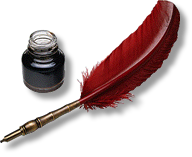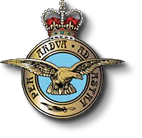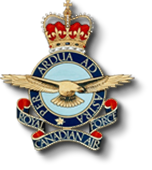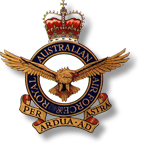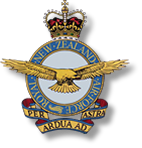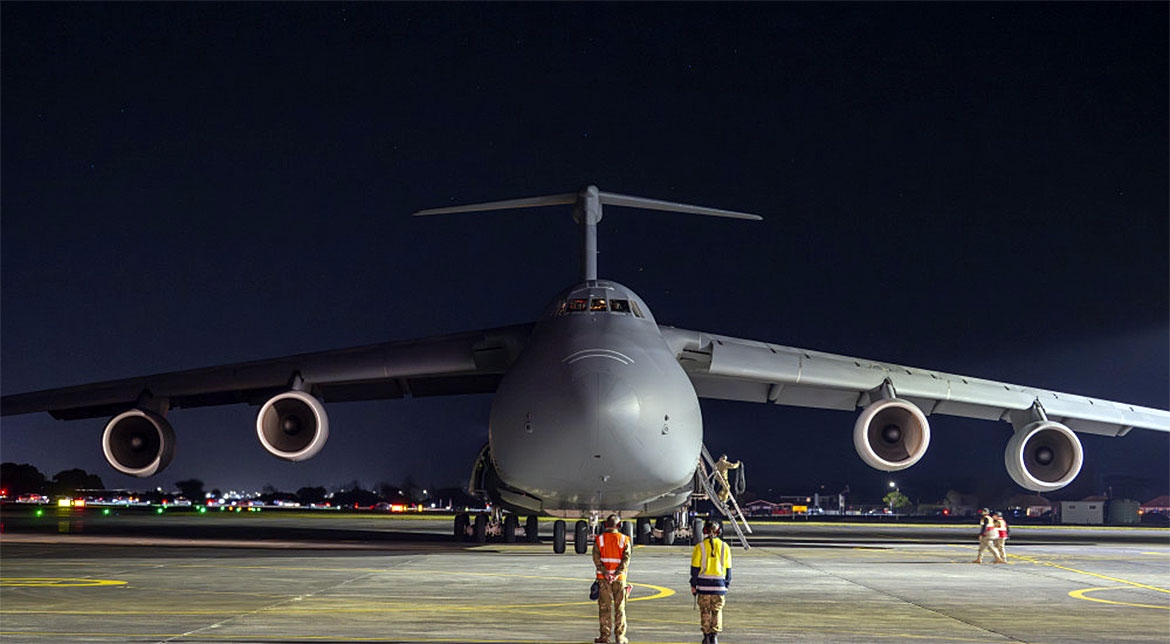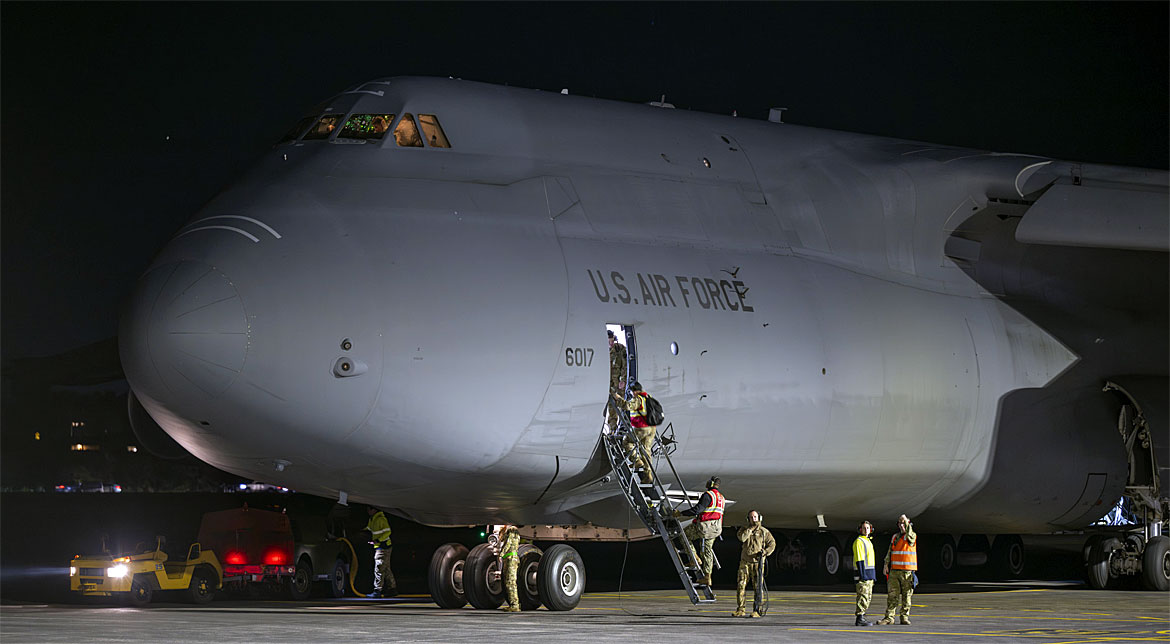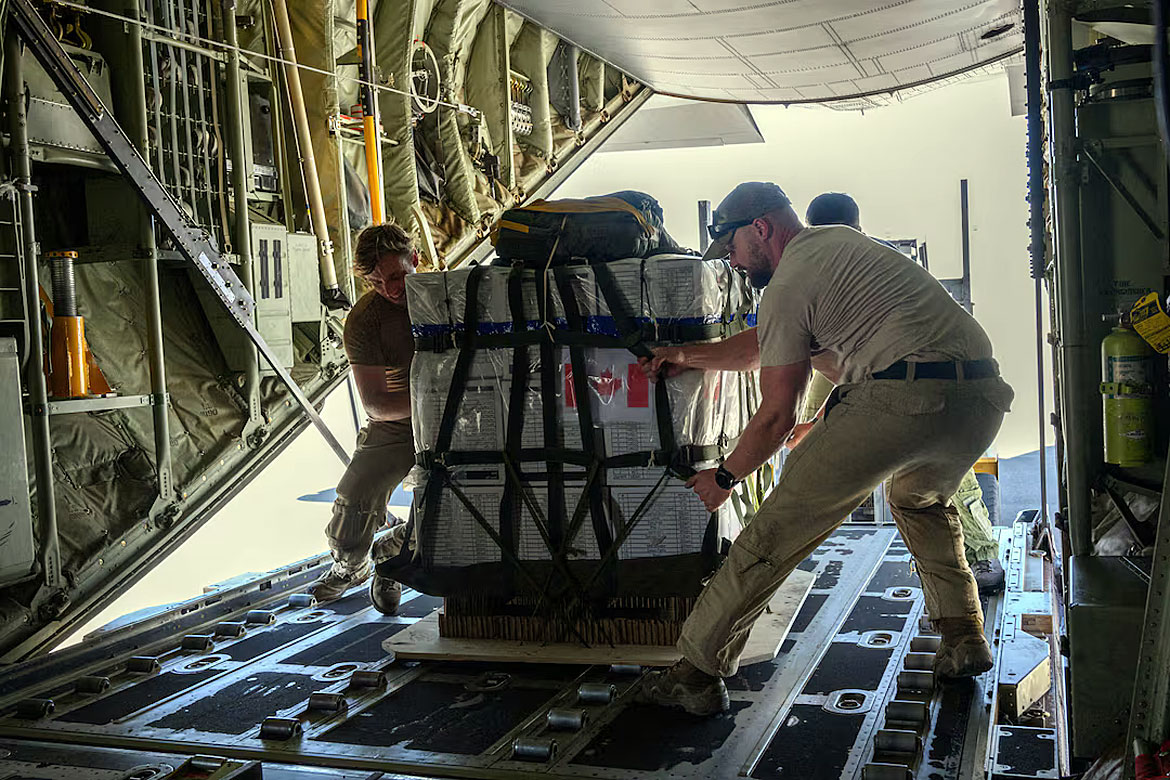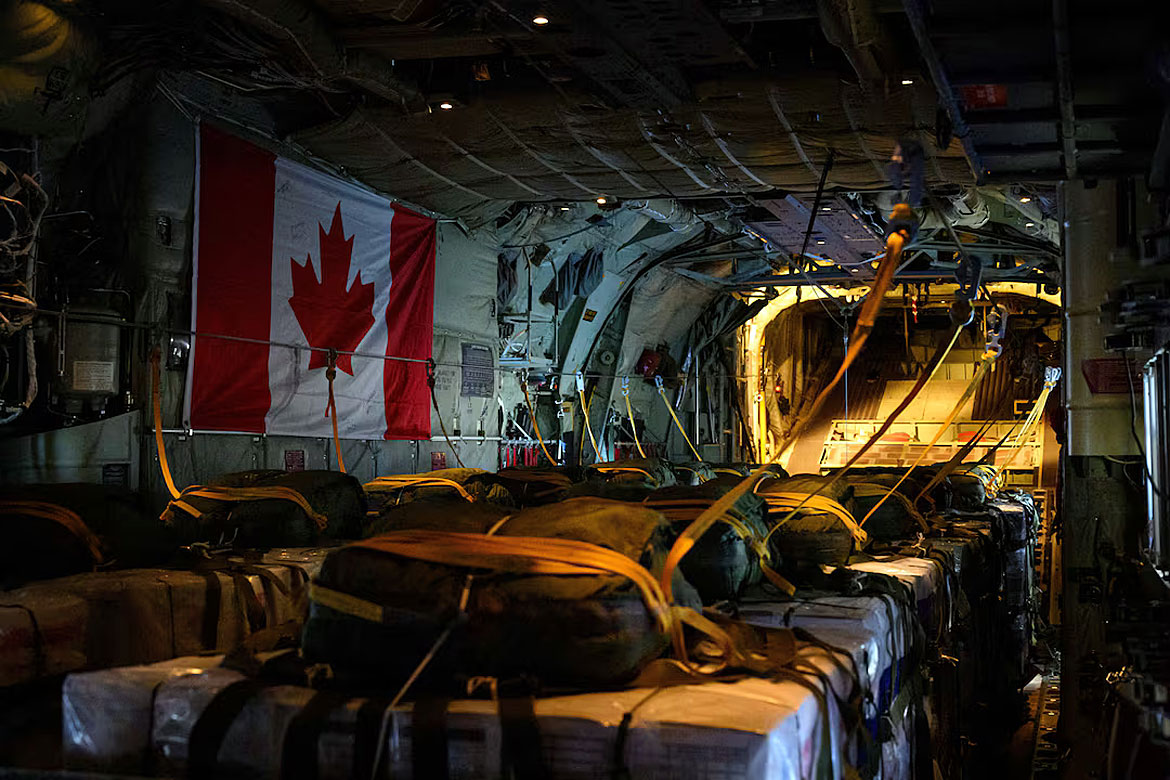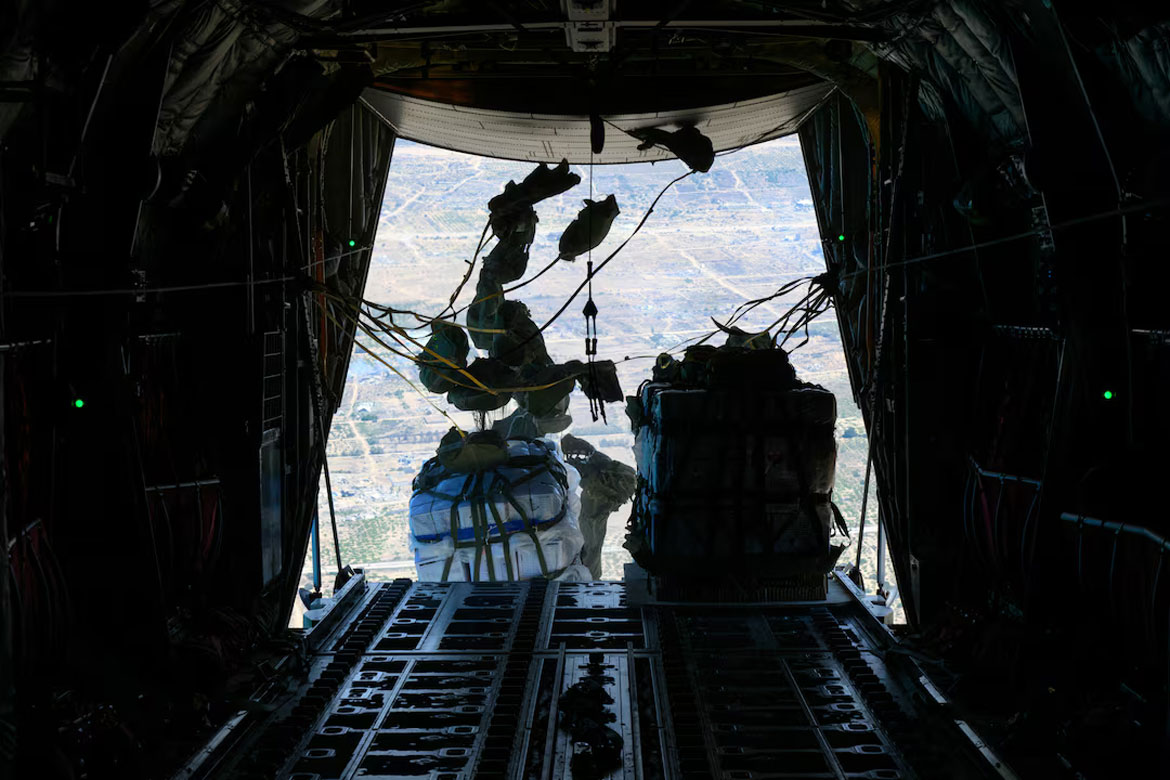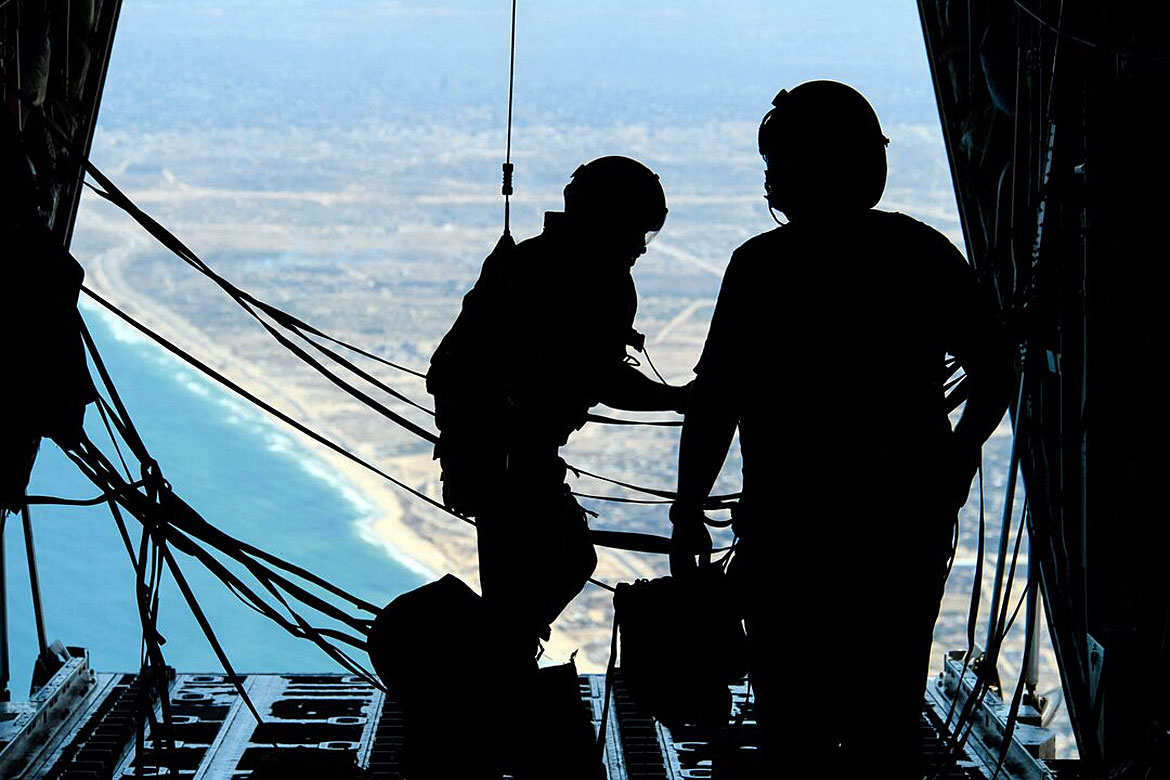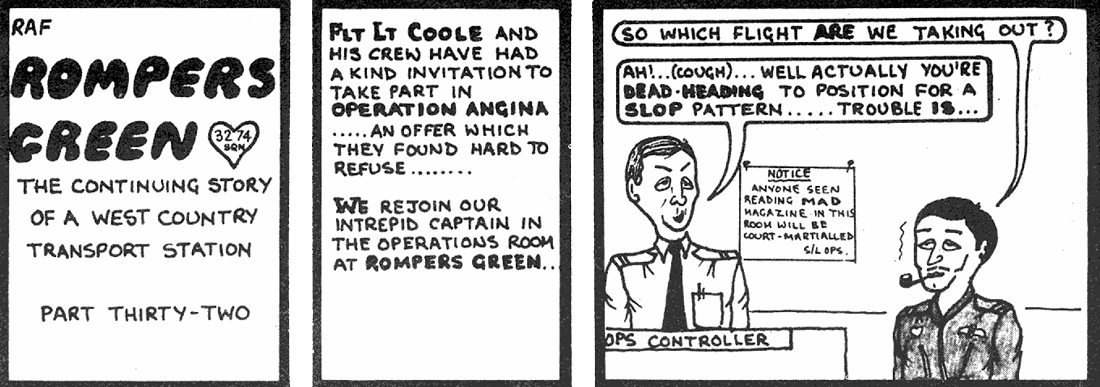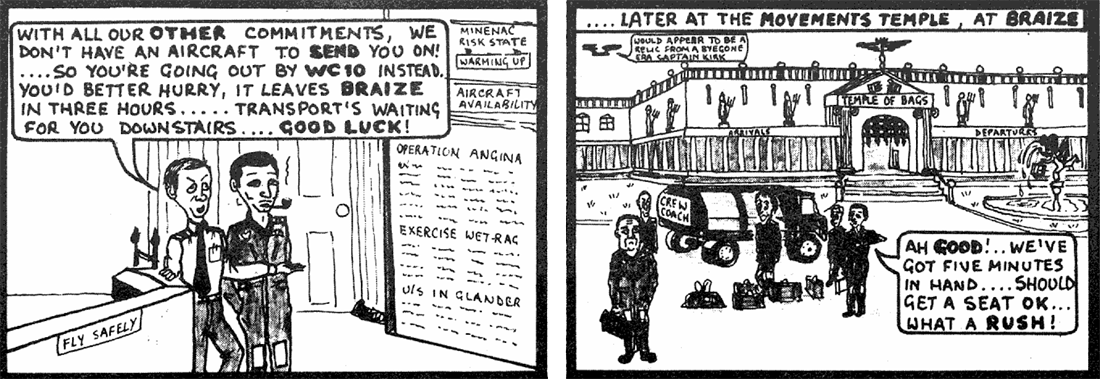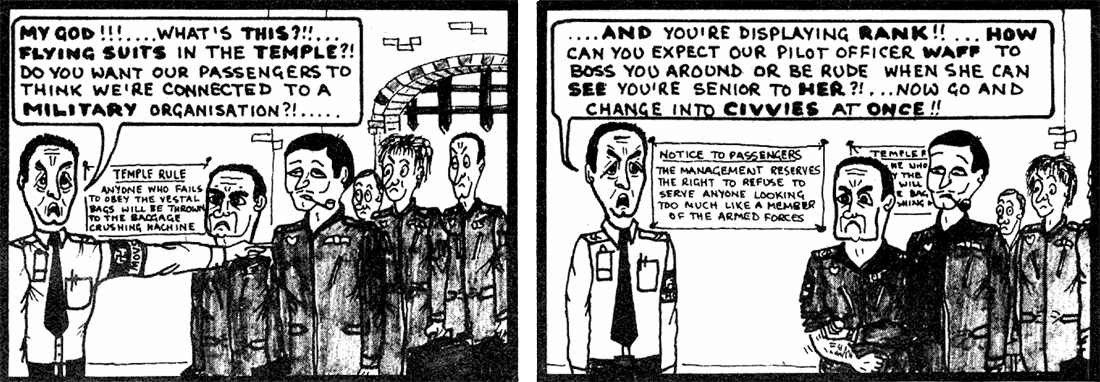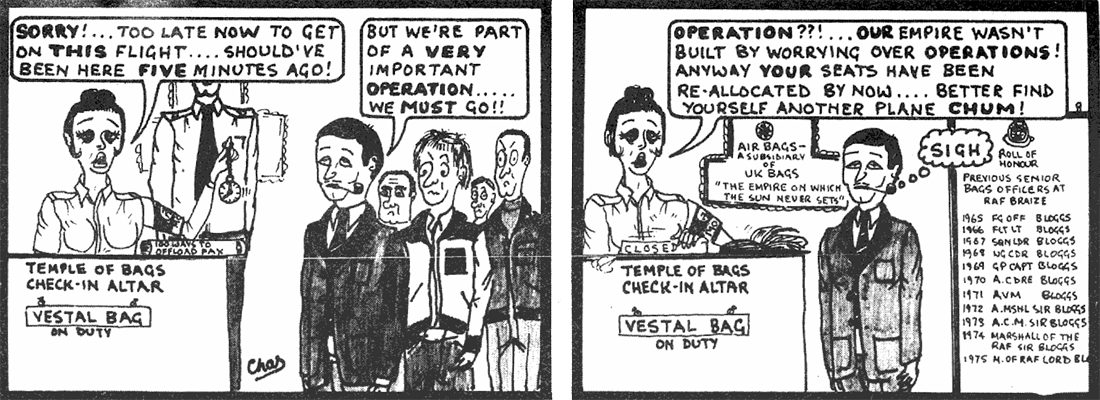

C-130J Hercules Simulator Arrives at RNZAF Base Auckland

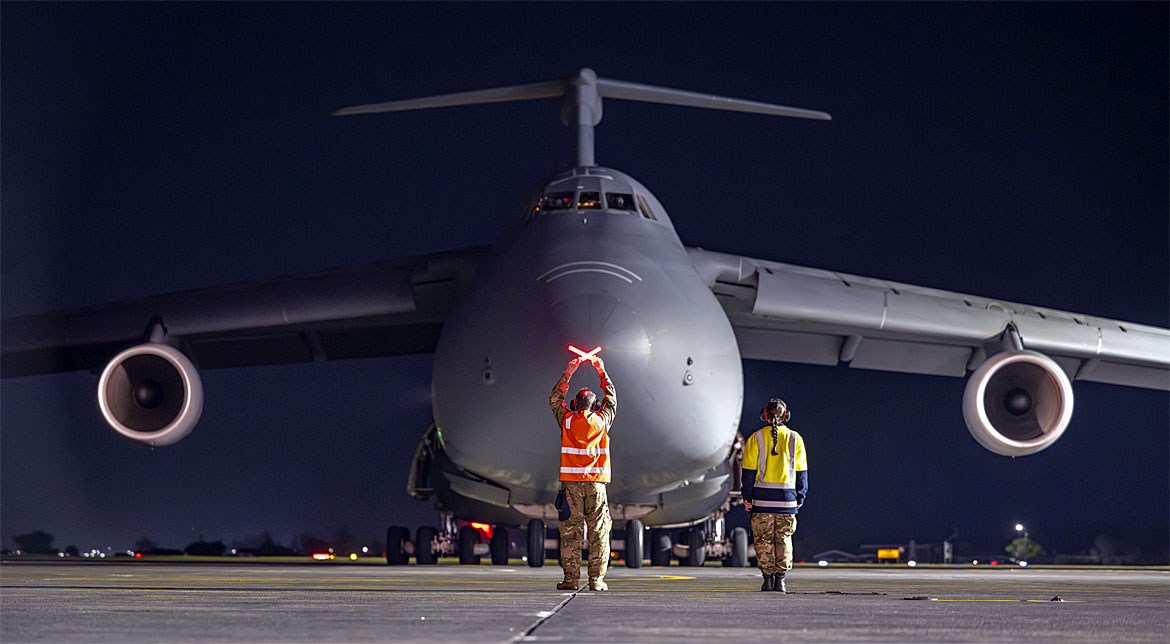
The United States Air Force’s (USAF) C-5M Super Galaxy aircraft touched down at Base Auckland with components for the C-130J Hercules Weapons Systems Trainer, a full-motion flight simulator. The equipment will train No. 40 Squadron crews, who operate the RNZAF’s newest fleet of five C-130J Hercules aircraft.
Air Component Commander Air Commodore Andy Scott said, “This is a really exciting time for the New Zealand Defence Force because the flight simulator is a critical tool that will provide pilot training, loadmaster systems training and engine run training, as well as procedural and mission systems training. It will also play a large role in ensuring our fleet is interoperable and our crews will be able to work alongside our international partners.”
The system is a full motion simulator designed to simulate the C-130J in a realistic manner. Once constructed, the simulator will look and move just like a real cockpit, simulating a range of realistic scenarios - from emergency operations to poor weather conditions.
“Simulators improve crew preparedness and free up the aircraft for operations. They reduce maintenance and flight time on actual aircraft, saving money, time and reducing risk,” Air Commodore Scott said.
Over the two flights, the C-5 Galaxy will deliver 58 crates of equipment, weighing a total of 49 tonnes.
An integrated project team, led by the Ministry of Defence, worked with USAF, CAE USA and Lockheed Martin to deliver the simulator. It will be ready for use from about the middle of next year. Construction and installation of the simulator at Base Auckland will start shortly within a purpose-built facility, which has already been completed.
The delivery of simulator components is part of a $1.5 billion project that delivered five C-130J Hercules aircraft, spare parts and training to the NZDF, as part of a Foreign Military Sales process.
nzdf.mil.nz
(There are two videos later in this edition)
Air Component Commander Air Commodore Andy Scott said, “This is a really exciting time for the New Zealand Defence Force because the flight simulator is a critical tool that will provide pilot training, loadmaster systems training and engine run training, as well as procedural and mission systems training. It will also play a large role in ensuring our fleet is interoperable and our crews will be able to work alongside our international partners.”
The system is a full motion simulator designed to simulate the C-130J in a realistic manner. Once constructed, the simulator will look and move just like a real cockpit, simulating a range of realistic scenarios - from emergency operations to poor weather conditions.
“Simulators improve crew preparedness and free up the aircraft for operations. They reduce maintenance and flight time on actual aircraft, saving money, time and reducing risk,” Air Commodore Scott said.
Over the two flights, the C-5 Galaxy will deliver 58 crates of equipment, weighing a total of 49 tonnes.
An integrated project team, led by the Ministry of Defence, worked with USAF, CAE USA and Lockheed Martin to deliver the simulator. It will be ready for use from about the middle of next year. Construction and installation of the simulator at Base Auckland will start shortly within a purpose-built facility, which has already been completed.
The delivery of simulator components is part of a $1.5 billion project that delivered five C-130J Hercules aircraft, spare parts and training to the NZDF, as part of a Foreign Military Sales process.
nzdf.mil.nz
(There are two videos later in this edition)

From: David Forsyth, St Hilaire de Riez
Subject: Re: UKMAMS OBA OBB #073125
Dear Tony,
Thanks for another brilliant edition of the newsletter. The RB 211 story reminded me of my Majunga Griffon Power plant/C130 tale which you published a while ago
My main reason for writing, though, is the Bill Girdwood story. Twenty years after his exploit, I had the privilege of first, working for Bill on Tornado Supply Management in Harrogate and then replacing him as Head of the Branch. He subsequently became a close friend and we remained in regular touch until he went to the UKMAMS tasking in the sky. Those who knew him will " hear" Bill in the way he committed the story to page - just as he spoke. And talking of writing - he had quite the most legible hand- writing I had ever seen and chided me frequently for mine which any GP would be proud to claim.
A delight of a man.
Thanks for your hard work, Tony.
David
Subject: Re: UKMAMS OBA OBB #073125
Dear Tony,
Thanks for another brilliant edition of the newsletter. The RB 211 story reminded me of my Majunga Griffon Power plant/C130 tale which you published a while ago
My main reason for writing, though, is the Bill Girdwood story. Twenty years after his exploit, I had the privilege of first, working for Bill on Tornado Supply Management in Harrogate and then replacing him as Head of the Branch. He subsequently became a close friend and we remained in regular touch until he went to the UKMAMS tasking in the sky. Those who knew him will " hear" Bill in the way he committed the story to page - just as he spoke. And talking of writing - he had quite the most legible hand- writing I had ever seen and chided me frequently for mine which any GP would be proud to claim.
A delight of a man.
Thanks for your hard work, Tony.
David


From: Chris Goss, Booker, Marlow, Bucks
Subject: RE: UKMAMS OBA OBB #073125
Tony,
Subject: RE: UKMAMS OBA OBB #073125
Tony,

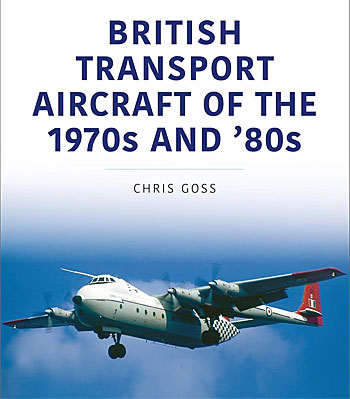
If we are asking about OBA members who have written books, I am now well into my 60s of books published [Available from Amazon].
The latest one, all 800 copies went in 3 weeks.
Nothing Movements-related (apart from my British Transport Aircraft of the 70s and 80s for which Andy Spinks kindly wrote the foreword).
I believe Mark Attrill has also had books published?
Best regards
Chris
The latest one, all 800 copies went in 3 weeks.
Nothing Movements-related (apart from my British Transport Aircraft of the 70s and 80s for which Andy Spinks kindly wrote the foreword).
I believe Mark Attrill has also had books published?
Best regards
Chris

Canada airdrops aid into Gaza
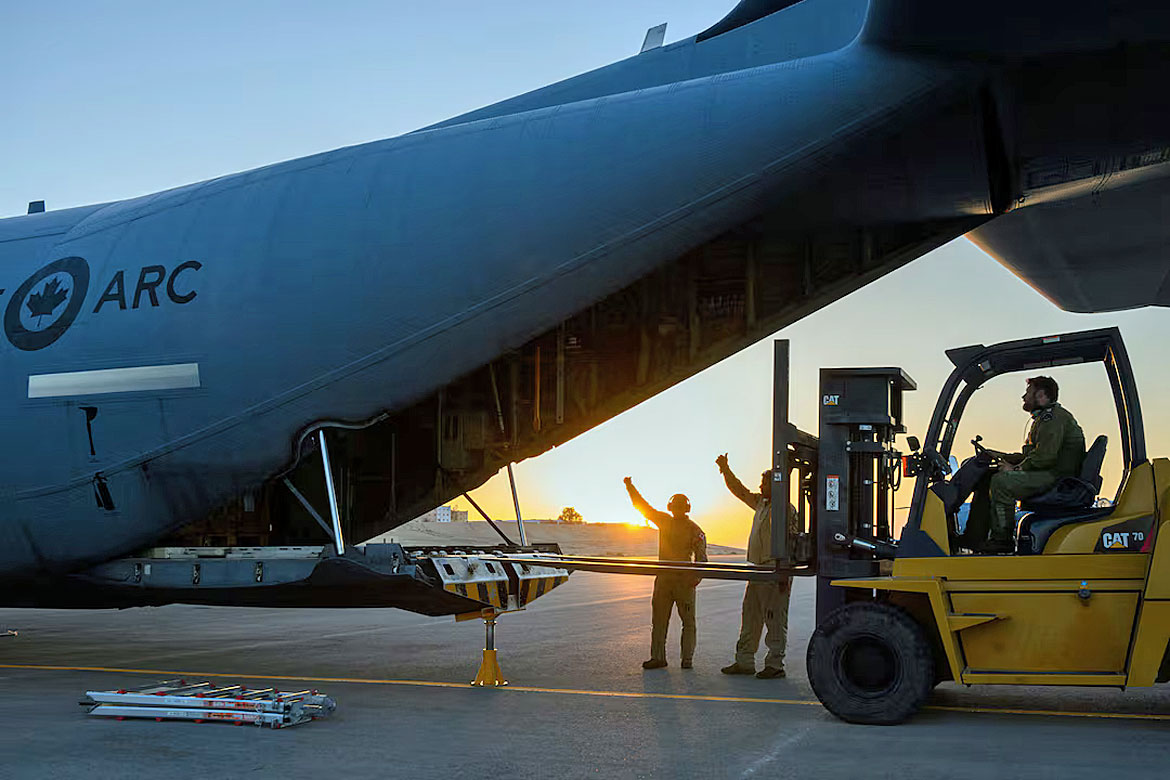
Canada said it has delivered humanitarian assistance through airdrops to Gaza, which has been under a devastating Israeli military assault for almost 22 months.
"The Canadian Armed Forces employed a CC-130J Hercules aircraft to conduct an airdrop of critical humanitarian aid in support of Global Affairs Canada into the Gaza Strip. The air drop consisted of 21,600 pounds of aid," the Canadian government said in a statement.
The Canadian Broadcasting Corporation reported that it was Canadian Armed Forces' first humanitarian airdrop over Gaza using their own aircraft.
The Israeli military said 120 food aid packages for Gaza's residents were airdropped by six countries, including Canada. The other five were Jordan, the United Arab Emirates, Egypt, Germany and Belgium.
reuters.com
"The Canadian Armed Forces employed a CC-130J Hercules aircraft to conduct an airdrop of critical humanitarian aid in support of Global Affairs Canada into the Gaza Strip. The air drop consisted of 21,600 pounds of aid," the Canadian government said in a statement.
The Canadian Broadcasting Corporation reported that it was Canadian Armed Forces' first humanitarian airdrop over Gaza using their own aircraft.
The Israeli military said 120 food aid packages for Gaza's residents were airdropped by six countries, including Canada. The other five were Jordan, the United Arab Emirates, Egypt, Germany and Belgium.
reuters.com
From: Dave Jones, Wellington
Subject: Re: UKMAMS OBA OBB #073125
Thanks for the latest update Tony,
Shocked and sad to see Bruce Oram in the list of casualties this time. Guess, we should all acknowledge we are getting older and I reflect that I have been out 25 years today (was my last day in Service), with the last two as Desk NCO for TG18B whilst at Innsworth. It was during this period I had a great working connection with Bruce when he was WO the School at BZN. I know Shirley (Mrs O), passed away some years ago and we had for some time kept in touch with the annual Christmas card.
As with many of those who have passed I valued and indeed cherished the relationships during my service, specifically the time as their career manager. I didn't always make friends with a posting or detachment to somewhere less desirable, but that is life in uniform I guess. For me, I am just about to semi-retire and head overseas to study for a PhD and in the process, and by default, a new language (Thai).
So, this evening I will raise a glass to an absent friend and to the many more who remain. Take care
Davey
Dave Jones
(Sgt Pers Admin - aka TG18B drafter)
Subject: Re: UKMAMS OBA OBB #073125
Thanks for the latest update Tony,
Shocked and sad to see Bruce Oram in the list of casualties this time. Guess, we should all acknowledge we are getting older and I reflect that I have been out 25 years today (was my last day in Service), with the last two as Desk NCO for TG18B whilst at Innsworth. It was during this period I had a great working connection with Bruce when he was WO the School at BZN. I know Shirley (Mrs O), passed away some years ago and we had for some time kept in touch with the annual Christmas card.
As with many of those who have passed I valued and indeed cherished the relationships during my service, specifically the time as their career manager. I didn't always make friends with a posting or detachment to somewhere less desirable, but that is life in uniform I guess. For me, I am just about to semi-retire and head overseas to study for a PhD and in the process, and by default, a new language (Thai).
So, this evening I will raise a glass to an absent friend and to the many more who remain. Take care
Davey
Dave Jones
(Sgt Pers Admin - aka TG18B drafter)

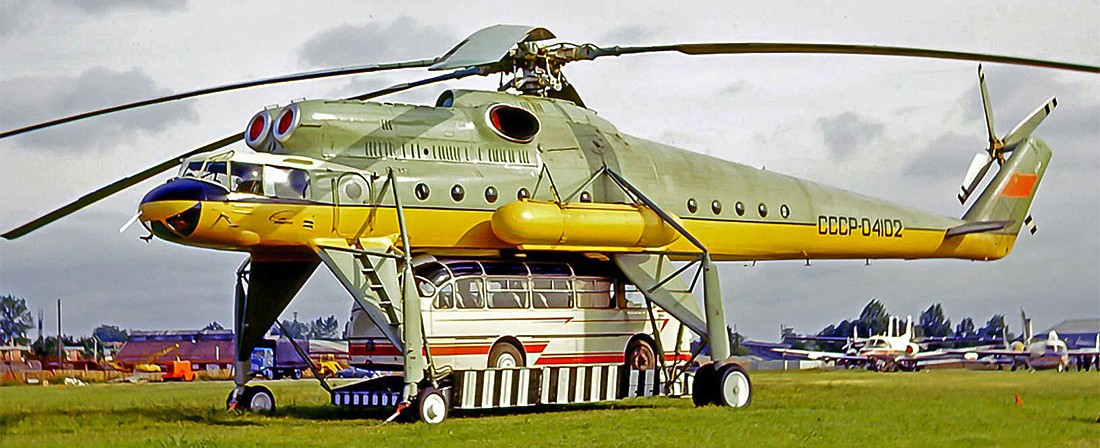
Helicopters often have a bad reputation for safety or performance, which is generally unfair.
However, some helicopters deserve to be flagged up for their failings. Unfortunately, the ten aircraft in this story have let the side down and are generally poorly designed, used for the wrong role, overly ambitious, or some combination of all three. In defence of some of these accursed choppers, they were all ahead of their time, and often pioneered new technologies. Let’s meet the 10 worst helicopters:
However, some helicopters deserve to be flagged up for their failings. Unfortunately, the ten aircraft in this story have let the side down and are generally poorly designed, used for the wrong role, overly ambitious, or some combination of all three. In defence of some of these accursed choppers, they were all ahead of their time, and often pioneered new technologies. Let’s meet the 10 worst helicopters:
Top 10: The Worst Helicopters
10: Petróczy, Kármán and Žurovec tethered helicopters
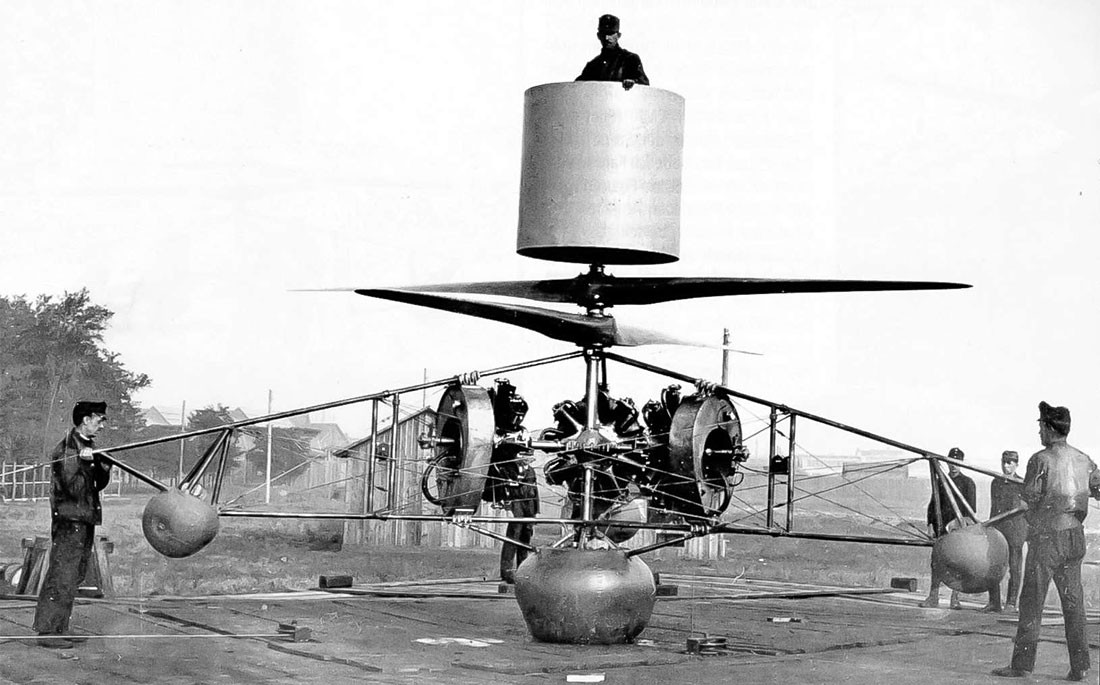
Today, small uncrewed drones powered by rotors or fans are a common sight on the battlefield. In addition to the attack role, their primary mission is carrying out battlefield reconnaissance, and it’s fascinating to learn that this basic idea is over 100 years old. However, it took a very long time for this technology to mature.
10 : Petróczy, Kármán and Žurovec tethered helicopters - Part 2
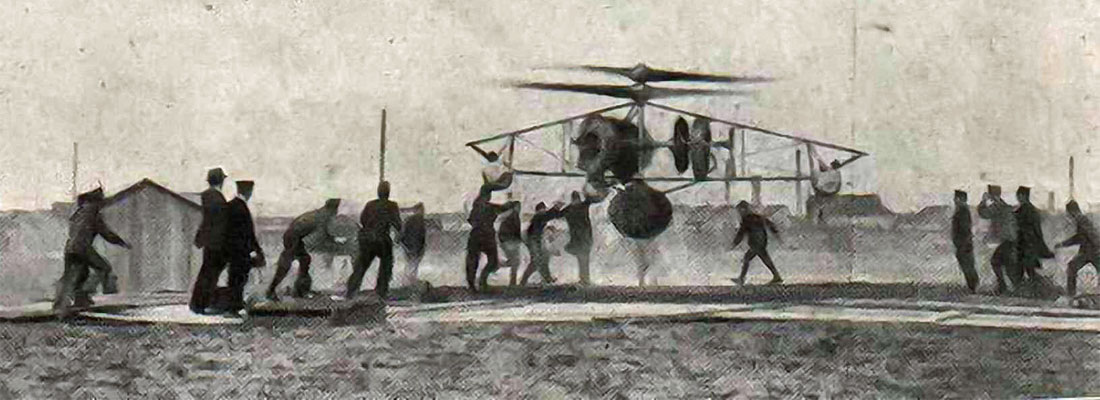
The PKŽ helicopters relied on twin contra-rotating rotors to counter torque. The PKZ-1 was powered by a single Austro-Daimler electric motor, the PKZ-2 initially by three Gnome rotary engines of 75 kW (100 hp). When the PKZ-2 was found to be underpowered, the engines were replaced with le Rhone rotary engines of 89 kW (120 hp).
On 10 June 1918, the PKZ-2 was demonstrated to officials, despite Žurovec’s doubts about the reliability of the le Rhone engines. He was right to worry, as when the engines spluttered out, the tether handlers understandably panicked, causing a crash-landing, damaging the craft and snapping the rotors.
On 10 June 1918, the PKZ-2 was demonstrated to officials, despite Žurovec’s doubts about the reliability of the le Rhone engines. He was right to worry, as when the engines spluttered out, the tether handlers understandably panicked, causing a crash-landing, damaging the craft and snapping the rotors.
9: Hiller YH-32 Hornet
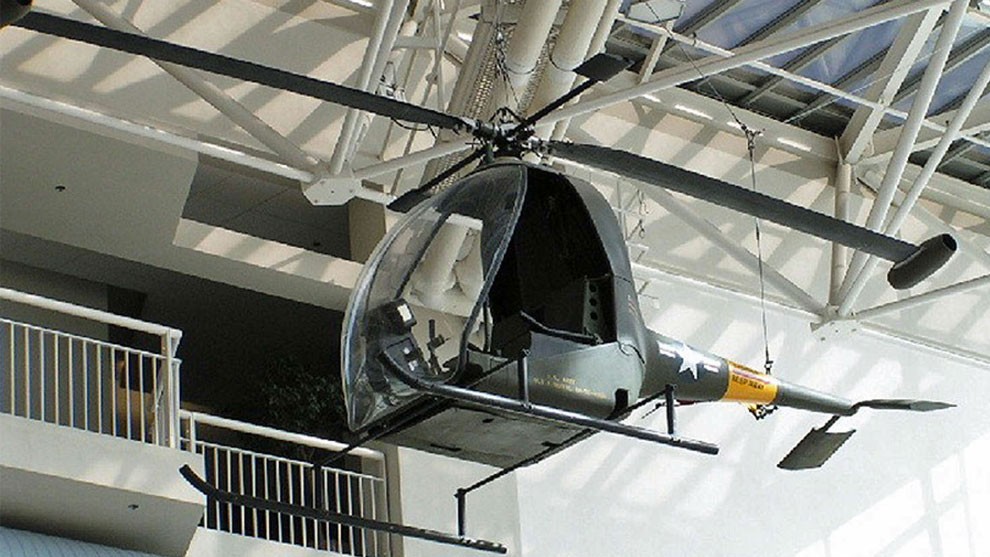
Helicopters are complex machines, but replacing the transmission system and piston (and later turbine) engines with tip ramjets created a far lighter, more straightforward solution. Indeed, the Hornet enjoyed 90 horsepower (68kW) from two ramjets mounted on the rotor tips, which each only weighed 13 pounds (5.9kg).
The ramjet is the simplest form of jet propulsion as it doesn’t require fans, just the speed of the air itself. Unfortunately, ramjets are also incredibly noisy and thirsty. Though its terrible range made the H-32 an impractical vehicle for military operations, it did much to pioneer US helicopter gunships.
The ramjet is the simplest form of jet propulsion as it doesn’t require fans, just the speed of the air itself. Unfortunately, ramjets are also incredibly noisy and thirsty. Though its terrible range made the H-32 an impractical vehicle for military operations, it did much to pioneer US helicopter gunships.
9: Hiller YH-32 Hornet - Part 2
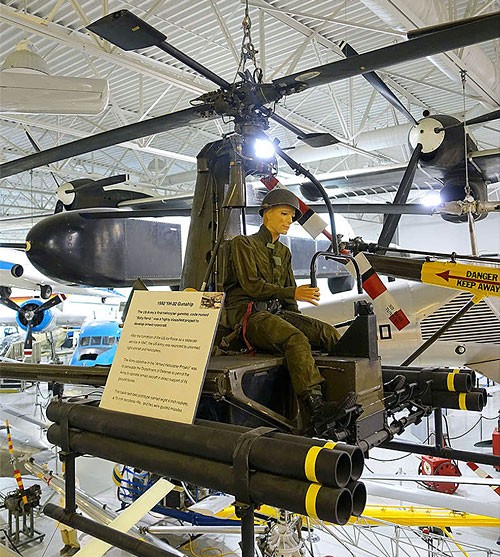
Intriguingly, some consider the YH-32A, nicknamed the Sally Rand (as it was "stripped to the bare essentials" like the Burlesque performer Sally Rand), the first helicopter gunship. Three YH-32As were tested in 1957 with various armaments including combinations of rockets, guided missiles, land-mine detectors, and even a 75mm recoilless cannon.
Despite the inherent issues of tip-jets, many tip-jet helicopter types have been built (or seriously considered), including the Avimech Dragonfly DF-1, the Dornier Do 32, Dornier Do 132, the Fiat 7002, Percival P.74, Sud-Ouest Ariel, Sud-Ouest Djinn and VFW-Fokker H3.
Despite the inherent issues of tip-jets, many tip-jet helicopter types have been built (or seriously considered), including the Avimech Dragonfly DF-1, the Dornier Do 32, Dornier Do 132, the Fiat 7002, Percival P.74, Sud-Ouest Ariel, Sud-Ouest Djinn and VFW-Fokker H3.
8: Hughes XH-17
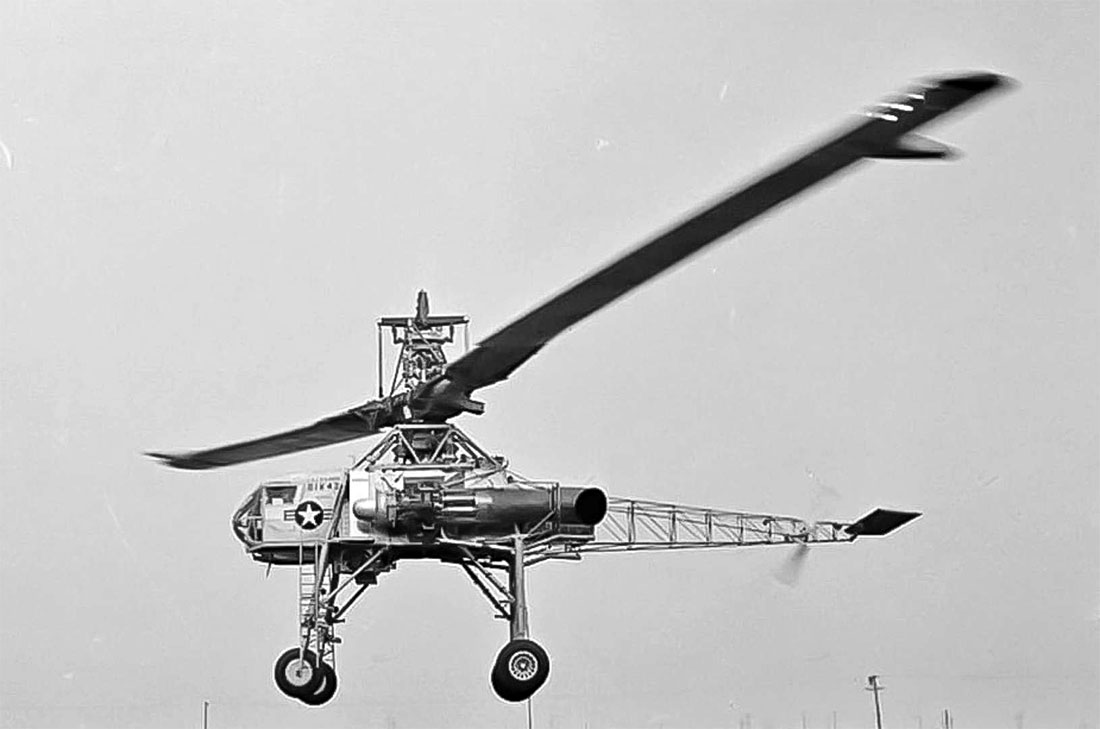
The XH-17 also featured tip-jet-driven rotors. But this point, any similarity with Hiller’s rather dainty helicopter ends, as the XH-17 was a massive beast. Starting life as a rotor test rig under the auspices of the Kellett Aircraft Corporation, the XH-17 ducted bleed air from the compressor sections of two GE J35 jet engines.
After travelling 65 feet to the ends of the oversized rotor blades, fuel was added to the airflow and ignited, producing four distinct jet plumes in the trailing edge…and a noise signature like an AC/DC concert, complaints being received from eight miles away.
After travelling 65 feet to the ends of the oversized rotor blades, fuel was added to the airflow and ignited, producing four distinct jet plumes in the trailing edge…and a noise signature like an AC/DC concert, complaints being received from eight miles away.
8: Hughes XH-17 - Part 2
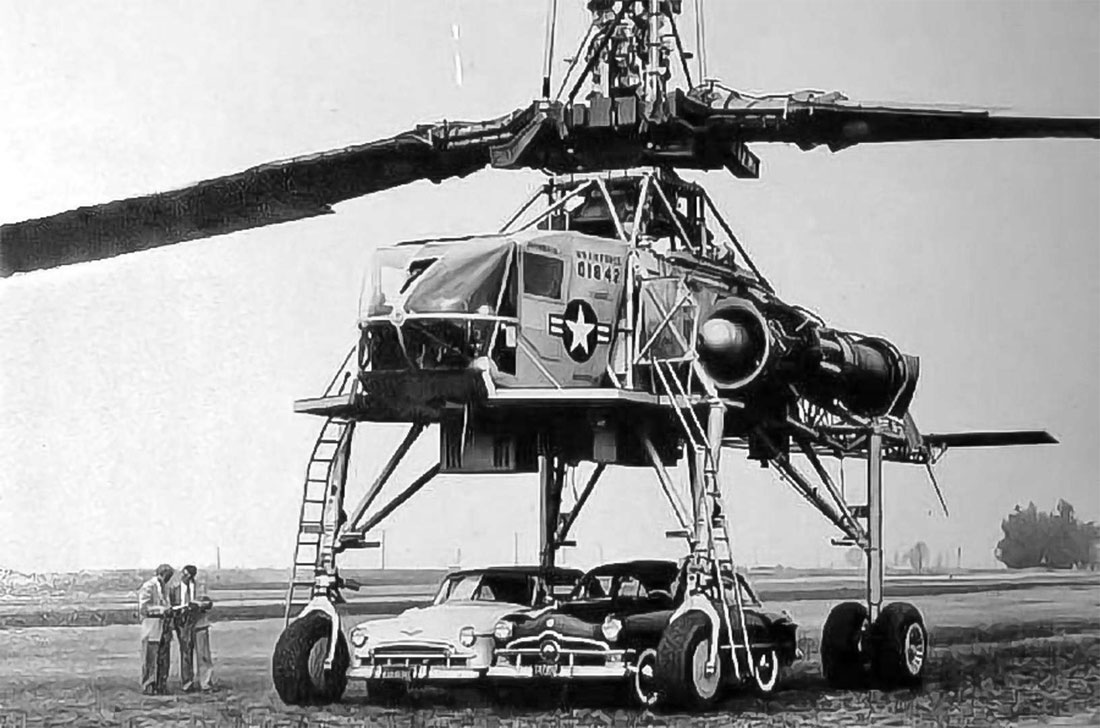
Facing financial issues, Kellett sold the XH-17 and their interest to the Hughes Aircraft Company. The first intentional flight took place, in 1952, when the XH-17 bounced wildly up and down. After some tinkering, Hughes managed to resolve the control issues, and the XH-17 entered an intensive 10-hour test programme, at which point the rotor’s fatigue life was used up.
Although there was a proposal for a four-bladed production version of the XH-17, the XH-28, the Army eventually decided not to pursue it. There was presumably not a massive requirement to move tanks across the battlefield at 80mph while being heard by everyone for many miles around.
Although there was a proposal for a four-bladed production version of the XH-17, the XH-28, the Army eventually decided not to pursue it. There was presumably not a massive requirement to move tanks across the battlefield at 80mph while being heard by everyone for many miles around.
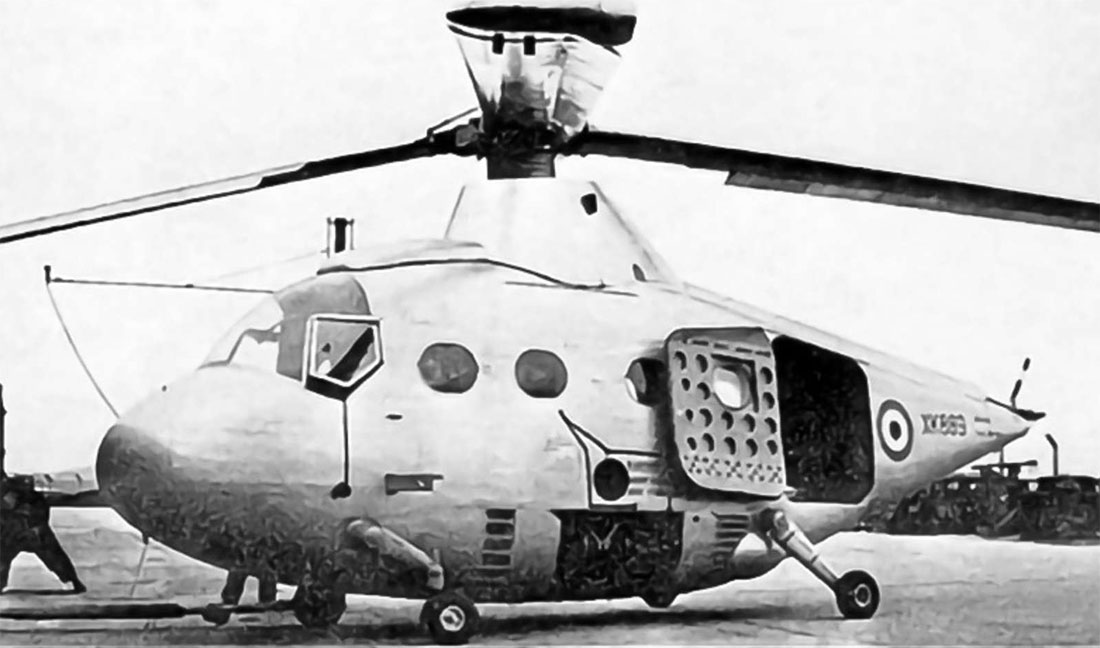
1950's were a time of great advances in aviation; the Percival P.74 was responsible for none of them. Looking as if the company’s designers were tasked to make a workable helicopter from a drawing by a three-year-old child, it featured a bulbous fuselage with tiny wheels and a comically out of proportion tail rotor.
Presumably feeling there was nothing left to lose it was decided to power it by using tip-jets to drive the rotors and control their pitch with trailing edge ailerons. The observant reader will notice both these features have failed to make it into widespread production today...
Presumably feeling there was nothing left to lose it was decided to power it by using tip-jets to drive the rotors and control their pitch with trailing edge ailerons. The observant reader will notice both these features have failed to make it into widespread production today...
7: Percival P.74
7: Percival P.74 - Part 2
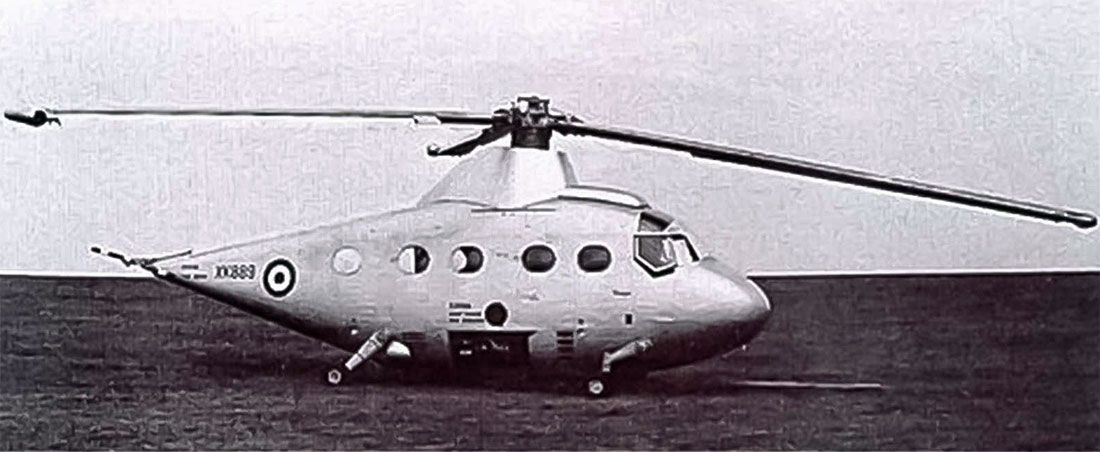
To provide air for the tip jets, two Napier Oryx gas turbines drove air compressors, the combined exhausts from both turbine and compressor then being ducted to the rotor tips. As someone had decided to put the engines in the belly this involved large ducts of hot air going up either side of the cabin, splitting it in two. They probably kept it warm, though. More worryingly, the only access to the cockpit was through the gap between these ducts, the sole door being at the back of the aircraft. This rather comical loser should not detract from Percival’s better aircraft, like the excellent, and exceptionally beautiful Mew Gull racer of the 1930s.
6: Agusta A106
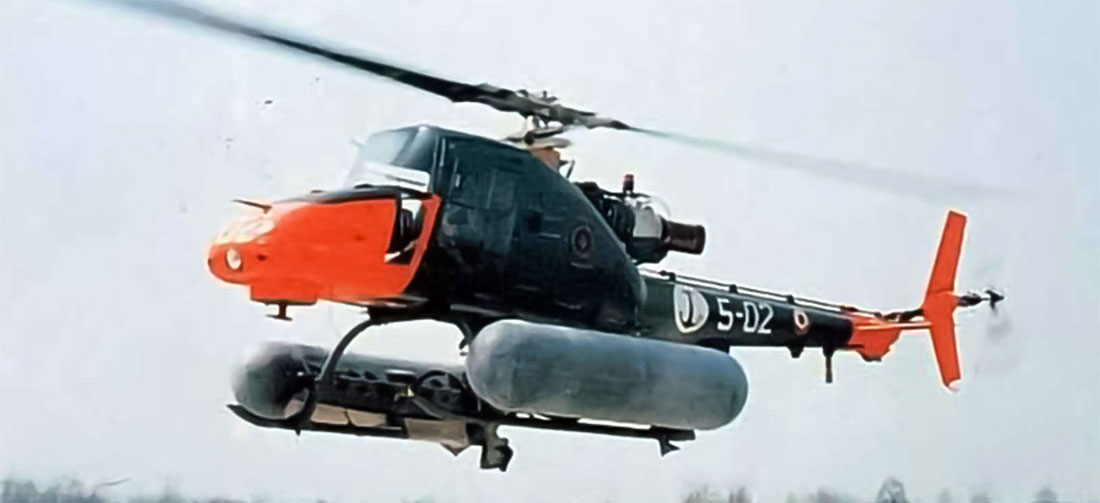
When the British Westland Wasp carried the rather alarming WE177A nuclear depth charge, it needed to remove its doors to meet the range requirement. Despite this, the Westland Wasp avoids being on this list because it is probably the only Anti-Submarine Warfare helicopter to have damaged a submarine, making you wonder what the rest of them have been doing with their time.
With a maximum take-off mass lower than the Wasp’s empty weight, the A106 was truly small; at 1400kg fully loaded, it weighs less than most cars today. This weight was achieved by only providing seating for one pilot, while two Mk 44 torpedoes could be hung under the fuselage, at this point, you must ask how much of the 800kg payload remained available for fuel.
With a maximum take-off mass lower than the Wasp’s empty weight, the A106 was truly small; at 1400kg fully loaded, it weighs less than most cars today. This weight was achieved by only providing seating for one pilot, while two Mk 44 torpedoes could be hung under the fuselage, at this point, you must ask how much of the 800kg payload remained available for fuel.
6: Agusta A106 - Part 2
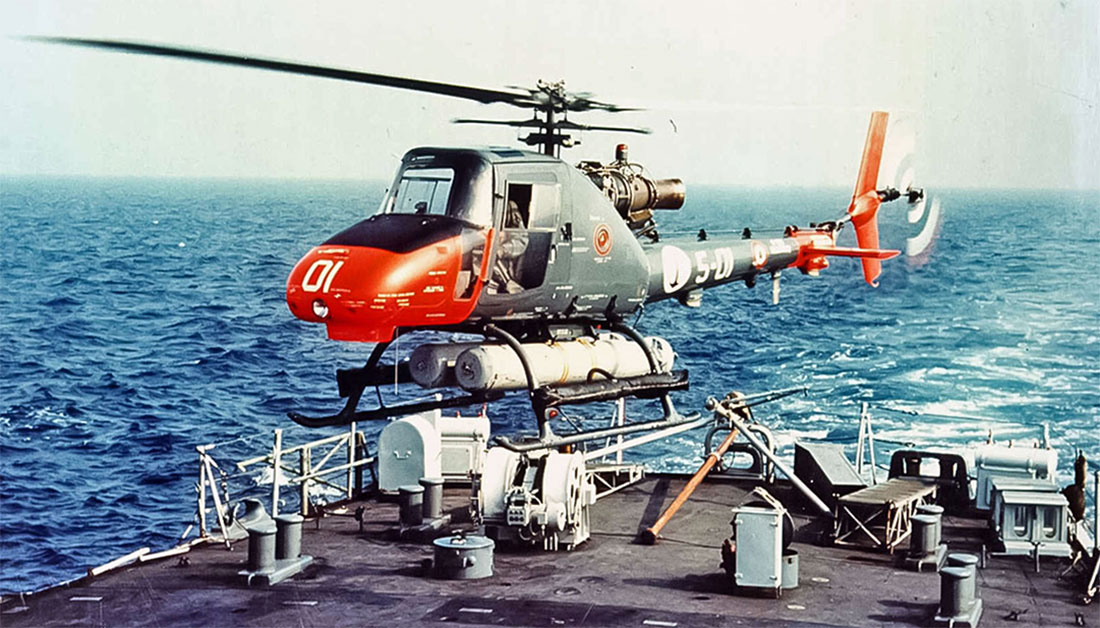
The absence of any other crew would have limited the A106 to carrying its payload where it was told to and then dropping it. Hopefully someone is available to tell the pilot how to get back as well, as photos of the cockpit show it to be remarkably lacking in avionics.
It’s at this point you start to wonder if Agusta realised they had created a crewed version of the QH-50 DASH torpedo-carrying drone, which had already entered service two years before the 106’s first flight in 1965. In the end only the two prototype A106s were built.
It’s at this point you start to wonder if Agusta realised they had created a crewed version of the QH-50 DASH torpedo-carrying drone, which had already entered service two years before the 106’s first flight in 1965. In the end only the two prototype A106s were built.
5: Westland 30
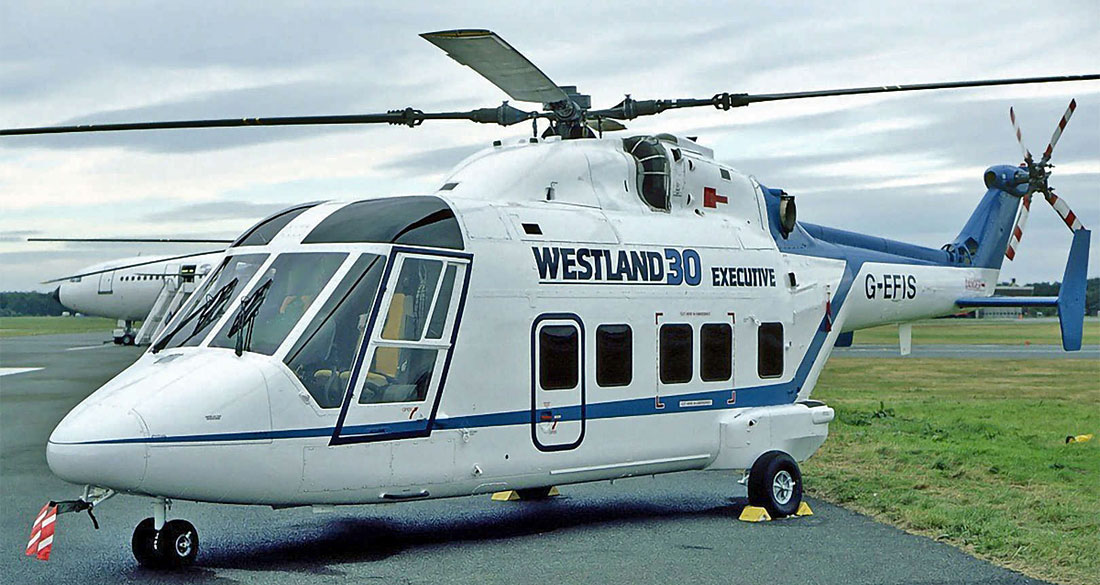
It’s the late ‘70s, and Westland is having success with its Lynx maritime attack helicopter. The next obvious move was to build on that by making a civilian version for the offshore and VIP market. Obvious, that is, if you’re not familiar with the Lynx, which is an ergonomic and audible nightmare, with average endurance, and a maintenance hours per-flying-hour problem.
The Westland 30-100 used the same rotors, engines and transmission as the Lynx but mated it with a boxier fuselage which could apparently seat 22. Which would have been a claustrophobic experience if sitting in the back of a 9-passenger configured Lynx is anything to go by.
The Westland 30-100 used the same rotors, engines and transmission as the Lynx but mated it with a boxier fuselage which could apparently seat 22. Which would have been a claustrophobic experience if sitting in the back of a 9-passenger configured Lynx is anything to go by.
5: Westland 30 - Part 2
The Westland 30 was also a heavy aircraft of almost 6000kg, a figure the Lynx wouldn’t get close to until the Mk 8 in the mid-90s. This didn’t do anything for the performance, the early Gem engines not being up to the task. Consequently, the WG30 was poor in range, power, and operating costs. On the plus side, it meant it rarely flew with more than about 10 people in the back, which must have made it quite roomy.
After two fatal crashes in 1988 and 1989 the fleet was grounded. Meanwhile, operators in the USA seemed no more enamoured of them with issues around the auto-stabilisation system, the maintenance levels required, and the lacklustre of customer support, issues that wouldn’t have surprised any Lynx operator.
After two fatal crashes in 1988 and 1989 the fleet was grounded. Meanwhile, operators in the USA seemed no more enamoured of them with issues around the auto-stabilisation system, the maintenance levels required, and the lacklustre of customer support, issues that wouldn’t have surprised any Lynx operator.
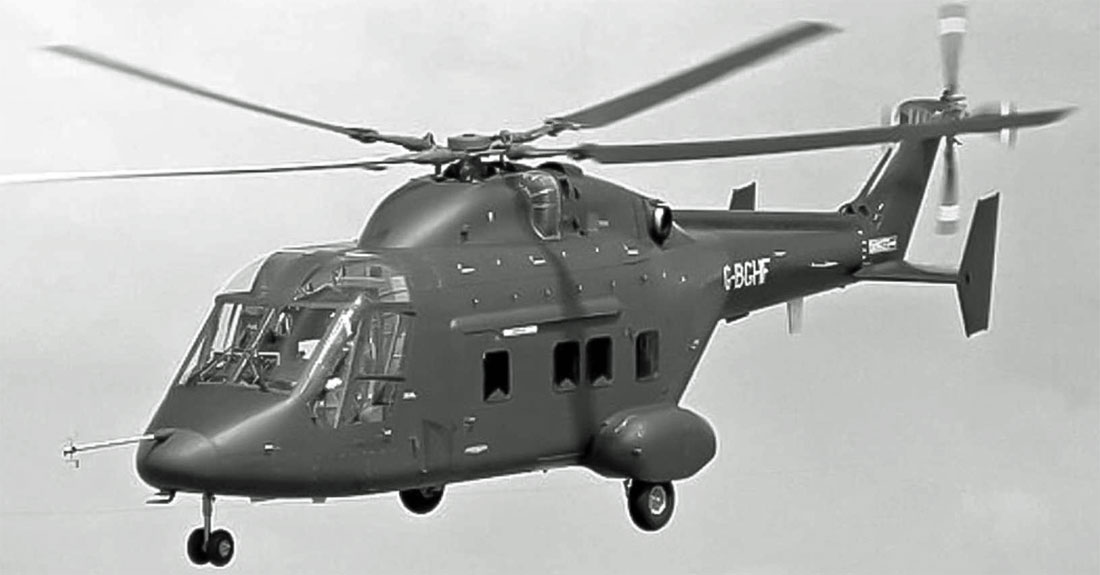
4: Mil Mi-10 'Harke'
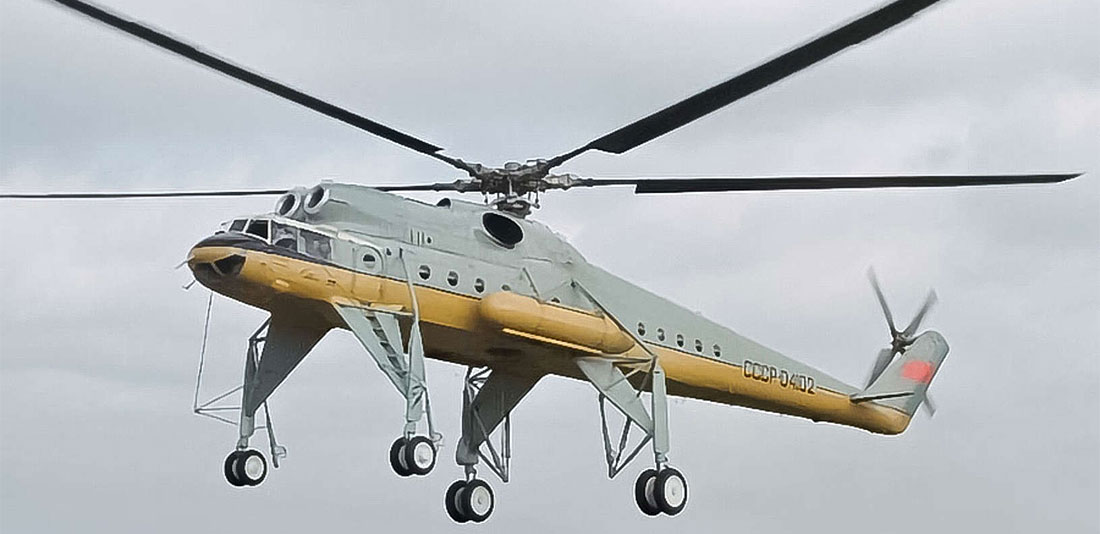
The Mi-6 combined a brilliantly eccentric aesthetic with being the world’s largest production helicopter. It was a truly glorious machine, and the lack of a nose-mounted conservatory in its successor, the Mi-26, leaves us all the poorer. The Mi-10, on the other hand, was a flying crane derivative of the Hook, which failed to live up to the glory of its older sister.
Removing the bottom half of the fuselage the resulting gap between the aircraft and the ground was filled with a stalky 3.75 metre tall, 6-metre-wide undercarriage. For reasons to do with helicopter aerodynamics, the right-hand legs were 300mm shorter than the left. Having built possibly the most ridiculous-looking landing gear known to man, there must have been some disappointment when it was found to shimmy while ground taxiing.
Removing the bottom half of the fuselage the resulting gap between the aircraft and the ground was filled with a stalky 3.75 metre tall, 6-metre-wide undercarriage. For reasons to do with helicopter aerodynamics, the right-hand legs were 300mm shorter than the left. Having built possibly the most ridiculous-looking landing gear known to man, there must have been some disappointment when it was found to shimmy while ground taxiing.
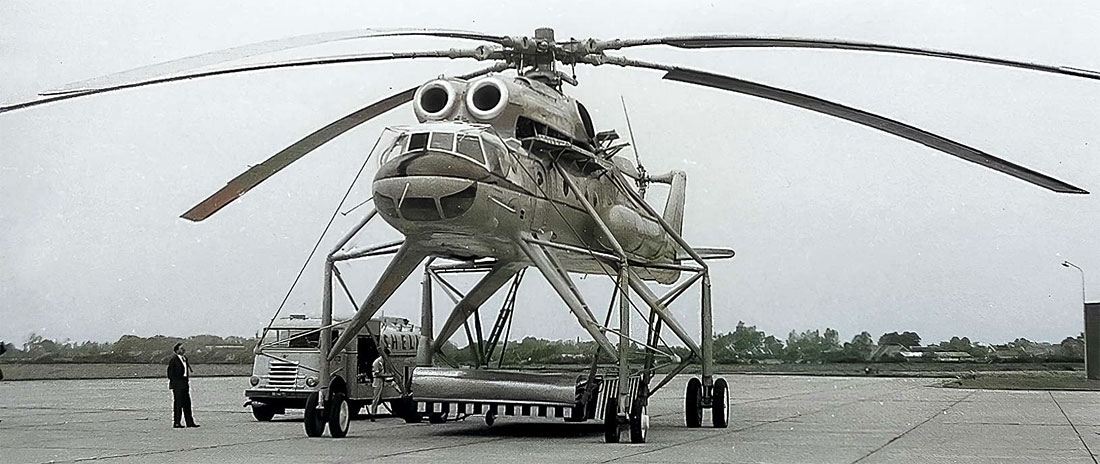
It was discovered that underslung loads were problematic due to the poor view from the cockpit even when using the CCTV system. Realising the requirement to carry a bus or prefab building underneath the fuselage wasn’t very useful, the later Mi-10K featured a two-metre shorter undercarriage and a second aft-facing cockpit underneath the first.
This made it much better for carrying underslung loads up to around 11,000kg in weight. Or about what you could get inside a Mi-6. This probably explains why only 55 or so Mi-10s were built in total; there are only so many times you need to move something you can’t get in or under a hook.
This made it much better for carrying underslung loads up to around 11,000kg in weight. Or about what you could get inside a Mi-6. This probably explains why only 55 or so Mi-10s were built in total; there are only so many times you need to move something you can’t get in or under a hook.
4: Mil Mi-10 'Harke' - Part 2
3: Yakovlev Yak-24 'Horse'
As part of a Stalin ‘inspired’ post-war rush to revive helicopter development, Yakovlev were ‘invited’ to design a heavy lift helicopter. The task seemed simple: make a boxy fuselage to put everything in and put a rotor at each end to lift it off the ground. As with most things helicopter-related, it turns out nothing is that simple.
Power was to be provided by the same Shvetsov Ash-82V engine, gearbox, and rotors as used in the Mi-4 Hare, except two of them. Presumably, due to sanity issues, one was placed just above the loading ramp, and the other was tilted over and squeezed behind the cockpit.
Power was to be provided by the same Shvetsov Ash-82V engine, gearbox, and rotors as used in the Mi-4 Hare, except two of them. Presumably, due to sanity issues, one was placed just above the loading ramp, and the other was tilted over and squeezed behind the cockpit.
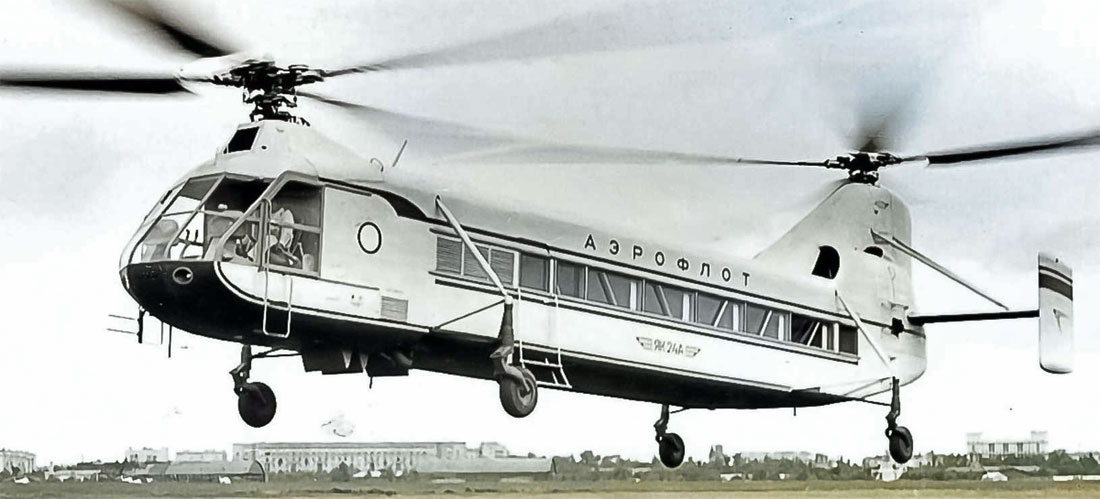
3: Yakovlev Yak-24 'Horse' - Part 2
To stop the blades from clashing, a synchronisation shaft connected the two gearboxes and allowed power to be transferred front to rear, or vice versa, in the event of an engine failure. Outside of this list, this has not proved a popular configuration.
The first indication that everything may not be right with the Horse came during ground testing when the rear rotor vibrated itself and its gearbox free and committed seppuku by ripping the fuselage apart. Further trials revealed that behaving like a tumble dryer with a brick in it was a feature of the Yak-24 that it might be an idea to design it out.
The first indication that everything may not be right with the Horse came during ground testing when the rear rotor vibrated itself and its gearbox free and committed seppuku by ripping the fuselage apart. Further trials revealed that behaving like a tumble dryer with a brick in it was a feature of the Yak-24 that it might be an idea to design it out.
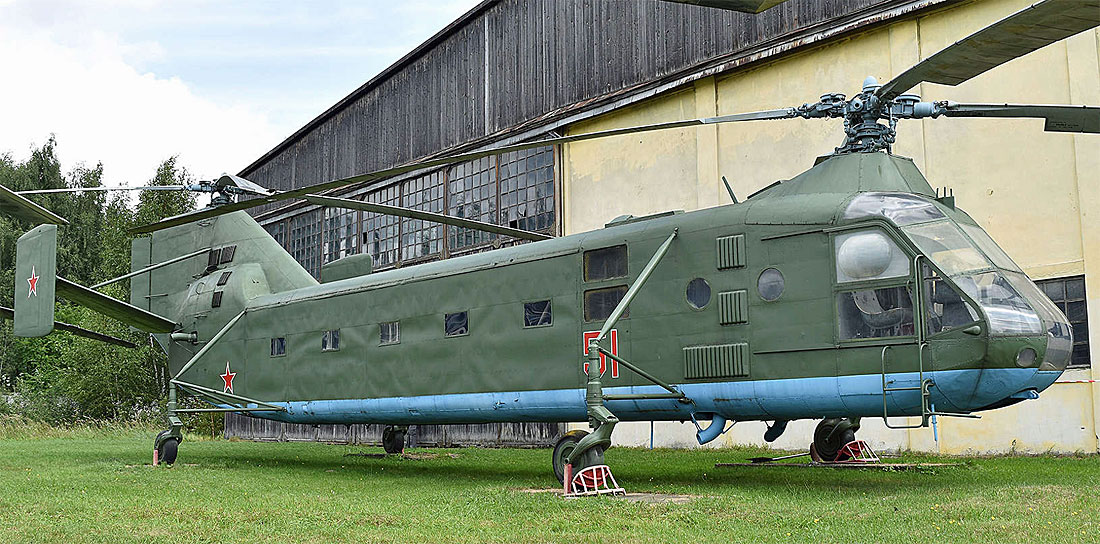
2: Bristol Belvedere
Failing to sell the helicopter to the Royal Navy as an Anti-Submarine Warfare aircraft, Bristol didn’t see any reason to radically change their design. So, they didn’t and sold it to the Royal Air Force (RAF) as a transport helicopter instead, despite a massively tall undercarriage designed to accommodate torpedoes. To be fair the RAF don’t seem to have thought to ask for any changes either.
This left troops trying to board through a door four feet off the ground as the fuselage was still high enough to allow torpedoes to be loaded on the underside. Which turned out not to be a major requirement in the jungles of Borneo due to the paucity of submarines. Taking a leaf out of Yakovlev’s book, Bristol put the engines at either end of the cabin.
This left troops trying to board through a door four feet off the ground as the fuselage was still high enough to allow torpedoes to be loaded on the underside. Which turned out not to be a major requirement in the jungles of Borneo due to the paucity of submarines. Taking a leaf out of Yakovlev’s book, Bristol put the engines at either end of the cabin.
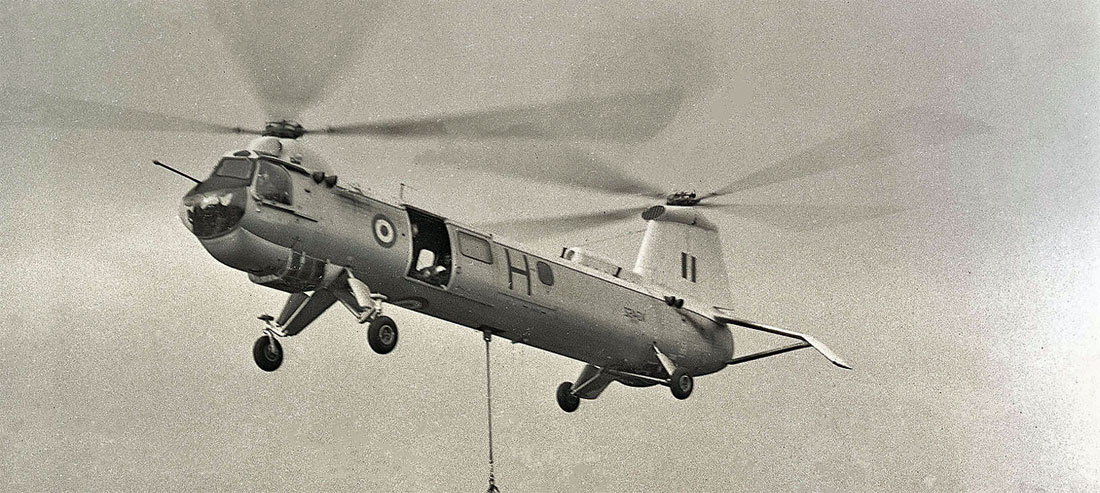
2: Bristol Belvedere - Part 2
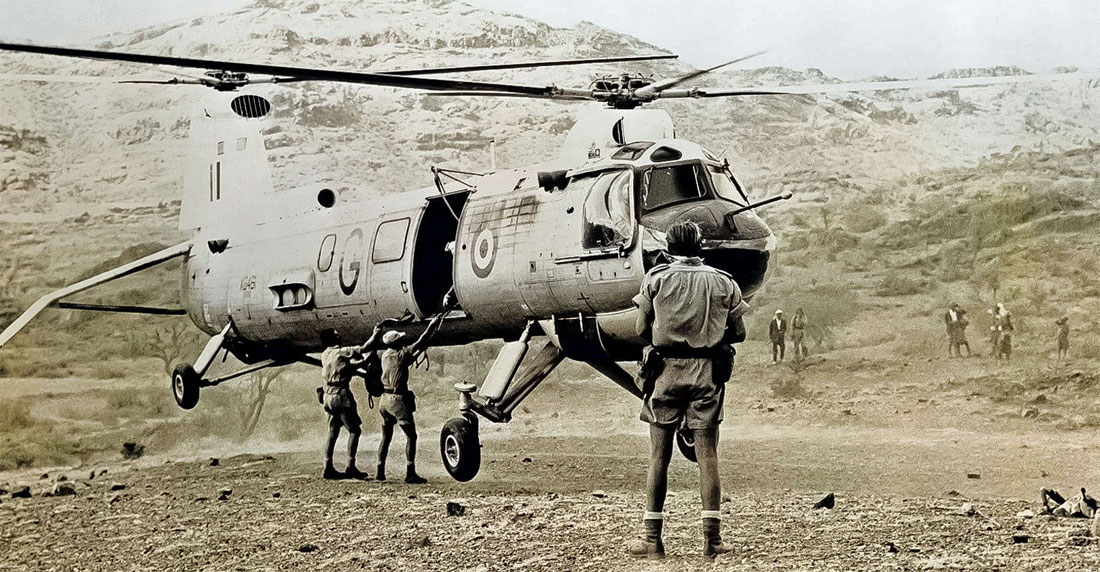
Going one further, they positioned the rear one in the fuselage, precluding the use of a loading ramp. Meanwhile, the one at the other end blocked access to the cockpit, which was probably a smart move but was ultimately defeated by installing a bulge on the left of the fuselage.
To make matters more interesting for the pilot the engines were started with AVPIN a substance which helpfully doesn’t need oxygen to burn and will happily do so if mishandled. This left them with the choice of squeezing back past the on-fire engine compartment or jumping to the ground and breaking an ankle.
To make matters more interesting for the pilot the engines were started with AVPIN a substance which helpfully doesn’t need oxygen to burn and will happily do so if mishandled. This left them with the choice of squeezing back past the on-fire engine compartment or jumping to the ground and breaking an ankle.
1: De Lackner HZ-1 Aerocycle
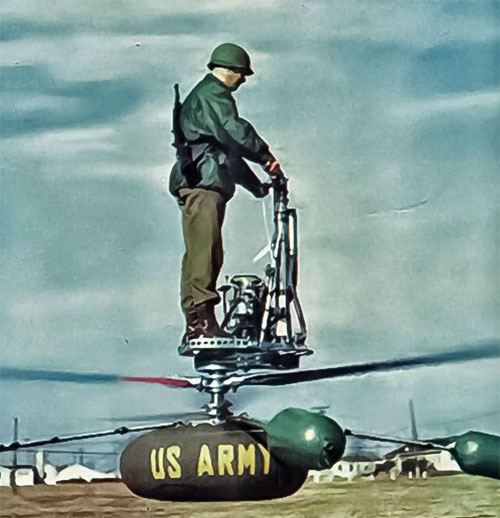
This is almost definitely a helicopter and was evaluated by the US Army as part of their plans to kill their own soldiers in new and imaginative ways. Eschewing such fripperies as a fuselage, seats, or actual controls, the HZ-1 was steered by the ‘pilot’ leaning in the direction he wanted to go.
For those wondering if they can build one in their own garage, the most complicated bit, the engine, was a converted Mercury outboard motor so the answer is probably yes. This drove two 15’ diameter contra-rotating rotor blades that, in two fingers to occupational health and safety, were placed below the sacrificial offering.
In the defence of the HZ-1, in trials, soldiers learnt to fly it with only twenty minutes of instruction before speeding across the landscape at up to 75mph. Although, with a range of only 15 miles it’s not immediately apparent that the turn of speed was particularly useful.
In the cons column, the HZ-1 suffered two (apparently non-fatal) accidents where the contra-rotating blades clipped each other and stopped working.
More worryingly, NACA was unable to repeat the phenomena in their wind tunnel, proving that even rocket scientists don’t understand helicopters. Combined with a moment of sanity, the US Army realised there wasn’t a lot of utility to the personal helicopter idea, which led to the end of the programme.
For those wondering if they can build one in their own garage, the most complicated bit, the engine, was a converted Mercury outboard motor so the answer is probably yes. This drove two 15’ diameter contra-rotating rotor blades that, in two fingers to occupational health and safety, were placed below the sacrificial offering.
In the defence of the HZ-1, in trials, soldiers learnt to fly it with only twenty minutes of instruction before speeding across the landscape at up to 75mph. Although, with a range of only 15 miles it’s not immediately apparent that the turn of speed was particularly useful.
In the cons column, the HZ-1 suffered two (apparently non-fatal) accidents where the contra-rotating blades clipped each other and stopped working.
More worryingly, NACA was unable to repeat the phenomena in their wind tunnel, proving that even rocket scientists don’t understand helicopters. Combined with a moment of sanity, the US Army realised there wasn’t a lot of utility to the personal helicopter idea, which led to the end of the programme.

From: David Powell, Princes Risborough, Bucks
Subject: Re: UKMAMS OBA OBB #073125
Hi Tony,
Thank you for putting together the latest OBA newsletter. What I found fascinating was the mix of handling the latest technology Atlas and Globemaster transport aircraft and the pre-technology stories from 40 plus years ago.
The fun days when if we had a Beverley over-nighter, we wouldn't be tasked for our next job until we actually got back after several nights down route including a couple of engine changes.
Best wishes
David
Subject: Re: UKMAMS OBA OBB #073125
Hi Tony,
Thank you for putting together the latest OBA newsletter. What I found fascinating was the mix of handling the latest technology Atlas and Globemaster transport aircraft and the pre-technology stories from 40 plus years ago.
The fun days when if we had a Beverley over-nighter, we wouldn't be tasked for our next job until we actually got back after several nights down route including a couple of engine changes.
Best wishes
David


From: Fred Hebb, Gold River, NS
Subject: Unplanned Extension to an Overseas Trip
Hi Tony;
Over the years, when I was a Loadmaster on C130s, I’ve had a few unexpected delays, most of which weren’t too bad.
I recall two Easter weekends in a row where we were stuck in Honolulu from Good Friday to the following Tuesday awaiting parts to be sent from Canada and having the aircraft repaired. I do not remember what the problem was but it had something to do with the pressurization. Once we got the part from Edmonton it was an easy fix and we were on our way.
Another trip was in the South Pacific with 426 Sqn on our way to Vietnam but when we got to Hong Kong we received a message from Ottawa to stay there awaiting orders. I was fortunate to have two good students with me so we enjoyed our stay in Hong Kong. Unfortunately we were on a two hour standby that restricted our sightseeing and selection of beverages however we did a fair amount of shopping. After a few days early one morning we got the call, went to the airport, had it off loaded and put the cargo in storage and was off to Saigon to participate in the orphan evacuation Operation Baby Lift along with a few Canadians. We flew the passengers to Hong Kong where they were flown to Vancouver on a CP Air flight. After a very long day, we carried on with our training mission making our way back to Canada.
Best Regards
Fred
Subject: Unplanned Extension to an Overseas Trip
Hi Tony;
Over the years, when I was a Loadmaster on C130s, I’ve had a few unexpected delays, most of which weren’t too bad.
I recall two Easter weekends in a row where we were stuck in Honolulu from Good Friday to the following Tuesday awaiting parts to be sent from Canada and having the aircraft repaired. I do not remember what the problem was but it had something to do with the pressurization. Once we got the part from Edmonton it was an easy fix and we were on our way.
Another trip was in the South Pacific with 426 Sqn on our way to Vietnam but when we got to Hong Kong we received a message from Ottawa to stay there awaiting orders. I was fortunate to have two good students with me so we enjoyed our stay in Hong Kong. Unfortunately we were on a two hour standby that restricted our sightseeing and selection of beverages however we did a fair amount of shopping. After a few days early one morning we got the call, went to the airport, had it off loaded and put the cargo in storage and was off to Saigon to participate in the orphan evacuation Operation Baby Lift along with a few Canadians. We flew the passengers to Hong Kong where they were flown to Vancouver on a CP Air flight. After a very long day, we carried on with our training mission making our way back to Canada.
Best Regards
Fred


The RCAF’s CC-130J Super Hercules Fleet Reaches 100,000 Flight Hours
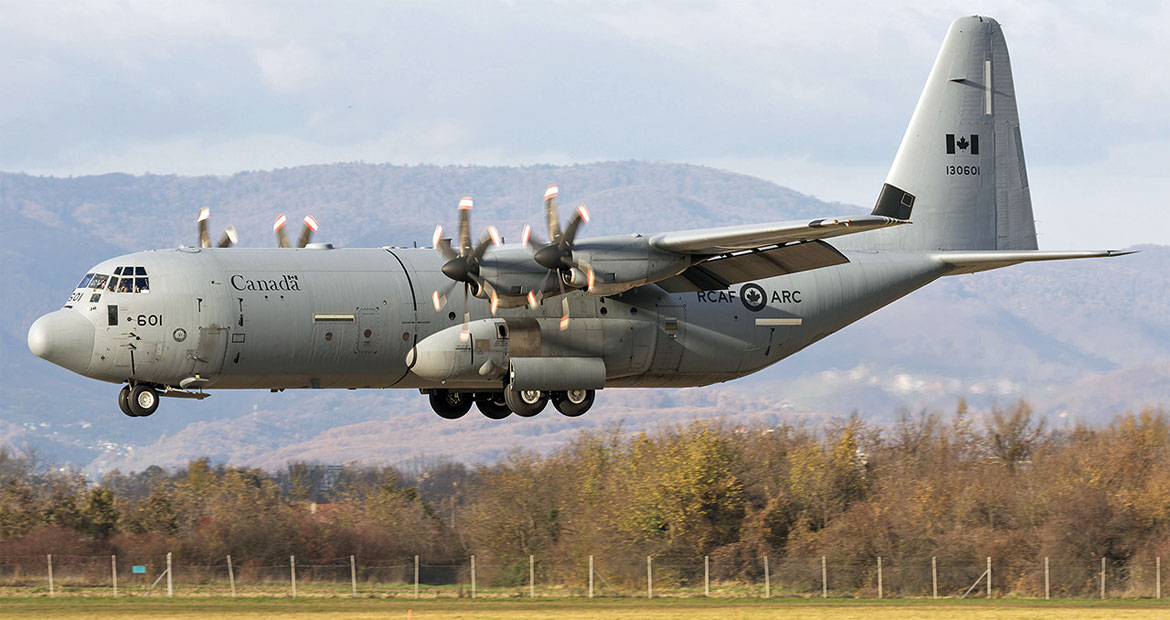
The Royal Canadian Air Force (RCAF) has reached an operational milestone by surpassing 100,000 accumulated flight hours with its fleet of CC-130J Super Hercules tactical transport aircraft, Lockheed Martin recently confirmed. This achievement highlights the key role of this aircraft in military missions for tactical troop and cargo transport, as well as in humanitarian support both within and beyond Canadian territory.
The induction of the CC-130J into the RCAF began in 2010, following the signing of a 2007 contract with Lockheed Martin for the acquisition of 17 new aircraft, intended to replace the aging CC-130E/H Hercules, which had been in service since the 1960s and 1970s. Currently, the entire fleet operates from 8 Wing, based at Trenton Air Base (Ontario), Canada’s main hub for military airlift operations.
This modernized variant of the Hercules offers significant improvements in payload capacity, range, and avionics compared to the Legacy versions. Among its technical features are the more powerful and efficient Rolls-Royce AE 2100D3 engines, as well as a digital cockpit (glass cockpit). With a payload capacity of up to 19 tons or room for 92 fully equipped soldiers, the CC-130J can cover distances greater than 5,250 kilometers with maximum load.
In 2016, the RCAF awarded a new contract to upgrade its aircraft to the Block 7.1/ADS-B standard, a modernization completed in 2020 that included enhancements in navigation and surveillance systems.
The RCAF’s CC-130Js have been deployed in numerous critical operations. Internationally, they have supported NATO missions in Eastern Europe and taken part in strategic evacuations, such as the 2021 withdrawal from Afghanistan. They have also been essential in humanitarian relief, most notably during the 2010 Haiti earthquake. Domestically, these aircraft play a vital role in the Canadian Arctic, a region of strategic interest where they ensure logistical transport and resupply to remote bases.
The milestone of 100,000 flight hours reached by the Canadian fleet reinforces the reputation of the C-130J Super Hercules as a reliable and versatile platform. Canada remains among the world’s leading operators of this model, alongside the United States, the United Kingdom, and Australia. With regular system upgrades, the RCAF’s Super Hercules will continue to be a cornerstone of Canada’s strategic projection, both in defense scenarios and in response to global crises.
.zona-militar.com
The induction of the CC-130J into the RCAF began in 2010, following the signing of a 2007 contract with Lockheed Martin for the acquisition of 17 new aircraft, intended to replace the aging CC-130E/H Hercules, which had been in service since the 1960s and 1970s. Currently, the entire fleet operates from 8 Wing, based at Trenton Air Base (Ontario), Canada’s main hub for military airlift operations.
This modernized variant of the Hercules offers significant improvements in payload capacity, range, and avionics compared to the Legacy versions. Among its technical features are the more powerful and efficient Rolls-Royce AE 2100D3 engines, as well as a digital cockpit (glass cockpit). With a payload capacity of up to 19 tons or room for 92 fully equipped soldiers, the CC-130J can cover distances greater than 5,250 kilometers with maximum load.
In 2016, the RCAF awarded a new contract to upgrade its aircraft to the Block 7.1/ADS-B standard, a modernization completed in 2020 that included enhancements in navigation and surveillance systems.
The RCAF’s CC-130Js have been deployed in numerous critical operations. Internationally, they have supported NATO missions in Eastern Europe and taken part in strategic evacuations, such as the 2021 withdrawal from Afghanistan. They have also been essential in humanitarian relief, most notably during the 2010 Haiti earthquake. Domestically, these aircraft play a vital role in the Canadian Arctic, a region of strategic interest where they ensure logistical transport and resupply to remote bases.
The milestone of 100,000 flight hours reached by the Canadian fleet reinforces the reputation of the C-130J Super Hercules as a reliable and versatile platform. Canada remains among the world’s leading operators of this model, alongside the United States, the United Kingdom, and Australia. With regular system upgrades, the RCAF’s Super Hercules will continue to be a cornerstone of Canada’s strategic projection, both in defense scenarios and in response to global crises.
.zona-militar.com

From: Mark Attrill, Tartu
Subject: Unplanned Extension to an Overseas Task
Hi Tony,
It was early February 1984 and my team was tasked with a routine re-supply run to Goose Bay and Winnipeg over a three-day period. While down-route we heard that the body of Flying Officer Joe Jackson, who had crashed on the Nellis Ranges during one of the annual RED FLAG exercises in Nevada, had been located and was now ready for collection and urgent repatriation back to the UK. I had been acquainted with Joe during my Initial Officer Training at RAFC Cranwell.
We swopped airframes at Winnipeg and did a quick turnaround at Nellis, departing late in the evening for Dulles. The original plan was to fly direct to Coltishall, but the next day the Captain informed us that the weather forecast across much of the UK was not good with severe fog in the South and South East. In accordance with GASOs, he planned a route Dulles to Brize Norton (for some reason Brize was still OK) with Lyneham as the nominated 'diversion' but advised us that it was his intention to actually land back at Lyneham - it was a well known ploy on the fleet to get around the vagaries of GASOs at the time.
We then departed on what became my longest ever flight on a C-130 (in terms of duration), arriving over the UK to find both Brize Norton and Lyneham socked in with fog. Undeterred, the Captain attempted his 'diversion' to Lyneham since the fog was marginally better there, but after three attempts at landing, we finally headed for RAF Valley which was the nearest airfield clear of fog.
We landed at 4.00am and then had to wait for the hearse to arrive from Coltishall (via Brize Norton). Upon arrival at RAF Valley, the Captain had tried to reduce the obligatory crew rest time for the crew because the Met Office advice was that fog would start to build up again in the early evening and if we left Valley too late we could potentially face the same issue overhead Brize Norton/Lyneham. The Captain's request was denied since we were no longer classed as a priority having handed over Joe's repatriation to an Undertaker and Group instructed us not to depart before 4.00pm. Lo' and behold, as we cruised across Mid-Wales and western England in the early evening, we could literally see the fog rolling in from the East and were quickly advised that Lyneham was now out.
After two fairly hairy approaches to Brize, we finally managed to land to discover, through the murk, almost half of the C-130 fleet also camped out at Brize! A three-day task turned into almost seven but that was just one of several extended trips during my relatively brief time on UK MAMS; never to anywhere exotic, unlike my team JNCO, Paddy Power, who always managed to get stuck in places like San Francisco when working with another team!
Many years later, in another life, my six-month tour in Sarajevo turned into almost nine-months because the Desk Officer 'forgot' to nominate a relief in time, but that's a story for another day.
Keep up the good work,
Mark
Subject: Unplanned Extension to an Overseas Task
Hi Tony,
It was early February 1984 and my team was tasked with a routine re-supply run to Goose Bay and Winnipeg over a three-day period. While down-route we heard that the body of Flying Officer Joe Jackson, who had crashed on the Nellis Ranges during one of the annual RED FLAG exercises in Nevada, had been located and was now ready for collection and urgent repatriation back to the UK. I had been acquainted with Joe during my Initial Officer Training at RAFC Cranwell.
We swopped airframes at Winnipeg and did a quick turnaround at Nellis, departing late in the evening for Dulles. The original plan was to fly direct to Coltishall, but the next day the Captain informed us that the weather forecast across much of the UK was not good with severe fog in the South and South East. In accordance with GASOs, he planned a route Dulles to Brize Norton (for some reason Brize was still OK) with Lyneham as the nominated 'diversion' but advised us that it was his intention to actually land back at Lyneham - it was a well known ploy on the fleet to get around the vagaries of GASOs at the time.
We then departed on what became my longest ever flight on a C-130 (in terms of duration), arriving over the UK to find both Brize Norton and Lyneham socked in with fog. Undeterred, the Captain attempted his 'diversion' to Lyneham since the fog was marginally better there, but after three attempts at landing, we finally headed for RAF Valley which was the nearest airfield clear of fog.
We landed at 4.00am and then had to wait for the hearse to arrive from Coltishall (via Brize Norton). Upon arrival at RAF Valley, the Captain had tried to reduce the obligatory crew rest time for the crew because the Met Office advice was that fog would start to build up again in the early evening and if we left Valley too late we could potentially face the same issue overhead Brize Norton/Lyneham. The Captain's request was denied since we were no longer classed as a priority having handed over Joe's repatriation to an Undertaker and Group instructed us not to depart before 4.00pm. Lo' and behold, as we cruised across Mid-Wales and western England in the early evening, we could literally see the fog rolling in from the East and were quickly advised that Lyneham was now out.
After two fairly hairy approaches to Brize, we finally managed to land to discover, through the murk, almost half of the C-130 fleet also camped out at Brize! A three-day task turned into almost seven but that was just one of several extended trips during my relatively brief time on UK MAMS; never to anywhere exotic, unlike my team JNCO, Paddy Power, who always managed to get stuck in places like San Francisco when working with another team!
Many years later, in another life, my six-month tour in Sarajevo turned into almost nine-months because the Desk Officer 'forgot' to nominate a relief in time, but that's a story for another day.
Keep up the good work,
Mark


From: Brian Hunt, Brighton, East Sussex
Subject: Unplanned Extension to an Overseas Trip
Tony,
BRICLOG KATHMANDU
This is not an extension but more “an avoidance of an extension”. When the Britannia fleet were doing the Gurkha trooping, they did return trips from Hong Kong to Kathmandu via Calcutta (as it was then). Aviation fuel in Nepal came overland in small bowsers from India, so most aircraft arrived with sufficient fuel to fly out again. The Britannia's stopped in Calcutta, refuelled (with the passengers on board) and then departed.
Before my time out there, aircraft had got stuck in Calcutta and it had been a nightmare for the crew to get the passengers through the airport and to find overnight accommodation. Indian bureaucracy was horrendous. Apart from anything else, we had to provide about 12 copies of every manifest, just for the flights transiting Calcutta!
As a result, crews did anything to avoid stopping there. This resulted in two unusual arrivals in Kathmandu. One aircraft had a snag with the undercarriage, so they flew all the way with it extended. The other arrived with only three engines working, the fourth having not produced full power from take off!
Subject: Unplanned Extension to an Overseas Trip
Tony,
BRICLOG KATHMANDU
This is not an extension but more “an avoidance of an extension”. When the Britannia fleet were doing the Gurkha trooping, they did return trips from Hong Kong to Kathmandu via Calcutta (as it was then). Aviation fuel in Nepal came overland in small bowsers from India, so most aircraft arrived with sufficient fuel to fly out again. The Britannia's stopped in Calcutta, refuelled (with the passengers on board) and then departed.
Before my time out there, aircraft had got stuck in Calcutta and it had been a nightmare for the crew to get the passengers through the airport and to find overnight accommodation. Indian bureaucracy was horrendous. Apart from anything else, we had to provide about 12 copies of every manifest, just for the flights transiting Calcutta!
As a result, crews did anything to avoid stopping there. This resulted in two unusual arrivals in Kathmandu. One aircraft had a snag with the undercarriage, so they flew all the way with it extended. The other arrived with only three engines working, the fourth having not produced full power from take off!


A photo of the offending aircraft
Thanks Tony for all your hard work and entertaining newsletters.
Yours,
Brian
Yours,
Brian

From: Mark Attrill, Edinburgh
Subject: Phil Philo
Hi Tony,
I am the midst of a house move back in the UK, but in the meantime I am hoping you can solve a mystery. If I recall correctly (though my memory is fading), there was a mention of Phil Philo passing away some years ago. He does not appear to feature as a member of the association although I believe he might have been on the Squadron at some point. I discovered a while back that a fellow retiree here in Edinburgh was friends with Phil but had not heard from him for a while and has assumed he had passed away.
My only exposure to him was when he was at BZN and then as a Movements Staff Officer at HQSTC when I was at HQ 1/38 Group in the mid-1980s.
Just wondering if you know or recall anything?
Thanks again,
Mark
Subject: Phil Philo
Hi Tony,
I am the midst of a house move back in the UK, but in the meantime I am hoping you can solve a mystery. If I recall correctly (though my memory is fading), there was a mention of Phil Philo passing away some years ago. He does not appear to feature as a member of the association although I believe he might have been on the Squadron at some point. I discovered a while back that a fellow retiree here in Edinburgh was friends with Phil but had not heard from him for a while and has assumed he had passed away.
My only exposure to him was when he was at BZN and then as a Movements Staff Officer at HQSTC when I was at HQ 1/38 Group in the mid-1980s.
Just wondering if you know or recall anything?
Thanks again,
Mark


From: Paul Kelly, Lyneham, Wilts
Subject: Unplanned Extension to an Overseas Task
Hi Tony,
Back in the mid-eighties, I spent six months on a posting to "Iggy Airways", colloquially known as RAF Belize. Halfway through the tour there remained only 12 x VC10's to turn around, no problems. The boss called me into his office; would I volunteer to extend my stay by a week as my replacement was delayed?
Finally, the new bloke arrives, good chap, one-day hand over, sorted. I spent the last week topping up my tan, and playing darts in the NAAFI!
Cheers!
Paul
Subject: Unplanned Extension to an Overseas Task
Hi Tony,
Back in the mid-eighties, I spent six months on a posting to "Iggy Airways", colloquially known as RAF Belize. Halfway through the tour there remained only 12 x VC10's to turn around, no problems. The boss called me into his office; would I volunteer to extend my stay by a week as my replacement was delayed?
Finally, the new bloke arrives, good chap, one-day hand over, sorted. I spent the last week topping up my tan, and playing darts in the NAAFI!
Cheers!
Paul


From: Kit Ayers, Stow-on-the-Wold, Glos
Subject: Unplanned Extension to an Overseas Trip
Tony,
In 1976 the civil charter Britannia contract for the support of MoD Procurement Executive (PE) trials in Southern Australia, mainly WRE Woomera and the Adelaide area, was terminated, with the support task transferred to the RAF ATF; mainly by Hercules tasking.
This got off to an inauspicious start with the first task being combined with a multi-sector training task which attracted a lot of extra aircrew and support personnel. This detracted from the task usable payload and space. The MoD (PE) planned load from RAAF Edinburgh Field (Adelaide) was only in part uplifted which caused consternation by the PE sponsor with a call to examine the aircraft utilisation upon return. Upon arrival it was found that a lot of “shopping - including bulky rattan furniture” was on board! Following this there was pressure to ensure that future support flights were closely managed, including max payload routing, to meet the intended task and not being a vehicle for other purposes. Consequently, following flights were routed and configured around the return load by close liaison with all of the tasking and the coordinating agencies including in Australia.
The nature of the loads and the relative urgency in relation to development trials involved exceptional waiving of DAC mixing rules, plus carriage of various explosive and highly flammable stores which called for dispersed aircraft parking down route. With the upgrading of Polaris in progress, AWRE became involved with nominated specialist escort officers. On one occasion an outbound load of trial missiles had to loaded last to be ready for jettison in emergency with an RLC Air Despatch Team included in the support crew. Forward of this were flammable items. Because of the loads' hazardous nature and special en-route parking, RAF Police security staff were carried for point guarding. Now running short of side para seats, the MAMS complement was limited to an “X” qualified officer as the load manager who had to utilise “available manpower” in any offload/onload tasks. After the first AWRE related task, their civilian escort officer was so disenchanted by the pleasures and comfort of Fat Albert travel that his task was passed to the MAMS officer who then had to go to Aldermaston for a special briefing.
Subject: Unplanned Extension to an Overseas Trip
Tony,
In 1976 the civil charter Britannia contract for the support of MoD Procurement Executive (PE) trials in Southern Australia, mainly WRE Woomera and the Adelaide area, was terminated, with the support task transferred to the RAF ATF; mainly by Hercules tasking.
This got off to an inauspicious start with the first task being combined with a multi-sector training task which attracted a lot of extra aircrew and support personnel. This detracted from the task usable payload and space. The MoD (PE) planned load from RAAF Edinburgh Field (Adelaide) was only in part uplifted which caused consternation by the PE sponsor with a call to examine the aircraft utilisation upon return. Upon arrival it was found that a lot of “shopping - including bulky rattan furniture” was on board! Following this there was pressure to ensure that future support flights were closely managed, including max payload routing, to meet the intended task and not being a vehicle for other purposes. Consequently, following flights were routed and configured around the return load by close liaison with all of the tasking and the coordinating agencies including in Australia.
The nature of the loads and the relative urgency in relation to development trials involved exceptional waiving of DAC mixing rules, plus carriage of various explosive and highly flammable stores which called for dispersed aircraft parking down route. With the upgrading of Polaris in progress, AWRE became involved with nominated specialist escort officers. On one occasion an outbound load of trial missiles had to loaded last to be ready for jettison in emergency with an RLC Air Despatch Team included in the support crew. Forward of this were flammable items. Because of the loads' hazardous nature and special en-route parking, RAF Police security staff were carried for point guarding. Now running short of side para seats, the MAMS complement was limited to an “X” qualified officer as the load manager who had to utilise “available manpower” in any offload/onload tasks. After the first AWRE related task, their civilian escort officer was so disenchanted by the pleasures and comfort of Fat Albert travel that his task was passed to the MAMS officer who then had to go to Aldermaston for a special briefing.
I was the Lyneham ACO and participated in 7 of these flights between December 1976 and November 1978. Only 2 ran to the Transop original schedule; the others experienced changes of route and varying delays. The longest of these was a 14-day task turning into 30 days; Flight 5096, which left Lyneham on 25th Jan 1978, eventually returning overhead Lyneham on 21 Feb, diverted to RAF Valley (due to fog at Brize) for a final night stop!
The Saga of 5096 - Flight 5096 departed Lyneham for Goose Bay on 25 January '76 with a mixed load of DAC including missiles for trials in Queensland and hydrazine liquid rocket fuel for Woomera. The latter had a strict temperature control range that necessitated avoidance of very cold or very hot night stop locations. Because of this it had to be kept in a heated hangar at Goose. En-route the aircraft, XV303, developed a leak problem with one prop creating a delay awaiting spares from the UK. Goose Bay in mid-winter was not the nicest place to while away time and was quite expensive since the on-base allowances did not cover the beer costs.
Following rectification, we departed Goose for McConnell AFB (Wichita) on the 28th January, and on arrival was refused a night stop by the base authorities because of the nature of the load, continued on to McClellan AFB (Sacramento). However, was diverted to Moffatt Naval Air Station (San Francisco Bay) due to weather, where we were very remotely parked. Being a Naval Air Station, they had no handling aids – the fork lifts were too high masted to get under the tail of the C130 for any load change. Again en-route the prop leak reoccurred causing another delay. Group suggested an airframe change with the one bringing the spares, but this was not possible, so XV303 was fixed and eventually was ready to continue on to Hickam for departure on 4th February. However, on start up a minor electrical fire initiated an airfield fire service call out, then it was found that fuel from the auxiliary tanks could not be accessed and without that fuel we cannot make Hawaii with sufficient usable fuel. By now the Moffat authorities were heartily sick of our presence so it was decided to move the aircraft to McClellan. Then it was found that with the high fuel load and short distance to McClellan we would be too heavy to land! Moffat did not have any ability to accept fuel from defueling so the GE improvised and emptied the auxiliary tanks through layflat polythene tubing into a “honey truck". We then ferried to McClellan to await further spares which arrived on a VC10 and we eventually departed for Hickam on the 6th February; the day that we should have returned to McClellan from Australia!
The Saga of 5096 - Flight 5096 departed Lyneham for Goose Bay on 25 January '76 with a mixed load of DAC including missiles for trials in Queensland and hydrazine liquid rocket fuel for Woomera. The latter had a strict temperature control range that necessitated avoidance of very cold or very hot night stop locations. Because of this it had to be kept in a heated hangar at Goose. En-route the aircraft, XV303, developed a leak problem with one prop creating a delay awaiting spares from the UK. Goose Bay in mid-winter was not the nicest place to while away time and was quite expensive since the on-base allowances did not cover the beer costs.
Following rectification, we departed Goose for McConnell AFB (Wichita) on the 28th January, and on arrival was refused a night stop by the base authorities because of the nature of the load, continued on to McClellan AFB (Sacramento). However, was diverted to Moffatt Naval Air Station (San Francisco Bay) due to weather, where we were very remotely parked. Being a Naval Air Station, they had no handling aids – the fork lifts were too high masted to get under the tail of the C130 for any load change. Again en-route the prop leak reoccurred causing another delay. Group suggested an airframe change with the one bringing the spares, but this was not possible, so XV303 was fixed and eventually was ready to continue on to Hickam for departure on 4th February. However, on start up a minor electrical fire initiated an airfield fire service call out, then it was found that fuel from the auxiliary tanks could not be accessed and without that fuel we cannot make Hawaii with sufficient usable fuel. By now the Moffat authorities were heartily sick of our presence so it was decided to move the aircraft to McClellan. Then it was found that with the high fuel load and short distance to McClellan we would be too heavy to land! Moffat did not have any ability to accept fuel from defueling so the GE improvised and emptied the auxiliary tanks through layflat polythene tubing into a “honey truck". We then ferried to McClellan to await further spares which arrived on a VC10 and we eventually departed for Hickam on the 6th February; the day that we should have returned to McClellan from Australia!
In the downtime created by this delay, we had to endure the sights of San Francisco, Fishermans` Wharf, Golden Gate bridge et al. All of this for Queen and Country.
McClellan to Hickam AFB. Arrived 6th February and departed 8th February for Nandi (Fiji). Then Hickam to Nandi arrived on the 8th February, departed 9th February for Townsville (Queensland, Australia). Townsville arrived early 9 February, offloaded the missiles on a QTR, continued on to Woomera WRE, arrived 9th Feb, offload and onload. WRE loading team involved the inimitable Aussi fork lift driver known as “Sardine” apparently so named because he was most of the time “f -ing canned”. Woomera departed 10th Feb for RAAF Richmond (near Sydney NSW), QTR, then to Nandi arrived 11th February.
Accommodated in Fiji at an inland hotel (normally they are on the coast) which had a large swimming pool and also a resident Air NZ 747crew. In the interests of “Empire” cohesion a very amicable beer disposal competition occurred in a floating bar in the middle of the pool. Next day (12th February) we left Nandi for Hickam – after about an hour airborne there was an EDP fault resulting in fuel dump and return to Nandi on 3 engines (overflying the hotel pool on the way in). This major fault required a full system flush which entails a flush rig and equipment to be sent from Lyneham by special task (halfway around the world!). A spec flight was tasked and instructions from a grumpy ATFOC for load and crew of 5096 to transfer to the relief airframe which was to assume the 5096 task with return to UK. Old airframe (XV303) to be repaired and recovered to Lyneham when serviceable. Lightning does strike twice, we had to suffer another 6 day delay! Lovely island.
McClellan to Hickam AFB. Arrived 6th February and departed 8th February for Nandi (Fiji). Then Hickam to Nandi arrived on the 8th February, departed 9th February for Townsville (Queensland, Australia). Townsville arrived early 9 February, offloaded the missiles on a QTR, continued on to Woomera WRE, arrived 9th Feb, offload and onload. WRE loading team involved the inimitable Aussi fork lift driver known as “Sardine” apparently so named because he was most of the time “f -ing canned”. Woomera departed 10th Feb for RAAF Richmond (near Sydney NSW), QTR, then to Nandi arrived 11th February.
Accommodated in Fiji at an inland hotel (normally they are on the coast) which had a large swimming pool and also a resident Air NZ 747crew. In the interests of “Empire” cohesion a very amicable beer disposal competition occurred in a floating bar in the middle of the pool. Next day (12th February) we left Nandi for Hickam – after about an hour airborne there was an EDP fault resulting in fuel dump and return to Nandi on 3 engines (overflying the hotel pool on the way in). This major fault required a full system flush which entails a flush rig and equipment to be sent from Lyneham by special task (halfway around the world!). A spec flight was tasked and instructions from a grumpy ATFOC for load and crew of 5096 to transfer to the relief airframe which was to assume the 5096 task with return to UK. Old airframe (XV303) to be repaired and recovered to Lyneham when serviceable. Lightning does strike twice, we had to suffer another 6 day delay! Lovely island.
Now the gods had decided retribution time had cometh. Fog at Lyneham created a diversion to Brize, after aborted approaches at both airfields, which in turn diverted the task to RAF Valley. Arrived Valley where exit from aircraft was delayed several hours awaiting Customs from Fishguard. Accommodated in messes at Valley which would not accept payment in US$ (only currency we had by then). Valley accounts officer had gone home and could not be called out. Dry old do. Departed Valley am 22nd February for Lyneham. Met my wife on the way home captaining a push chair who said “So, you have decided to come home? Go and sort out the MQ door I had to break the window this morning because I had locked myself out!! Sequel – attempt by crew to claim separation allowance (30 days away) rejected by Accounts because Valley was less than 200 miles from Lyneham required by the rules – can`t quite win them all.
Kit
Kit


British Atlas aircraft to get new system to drop boats
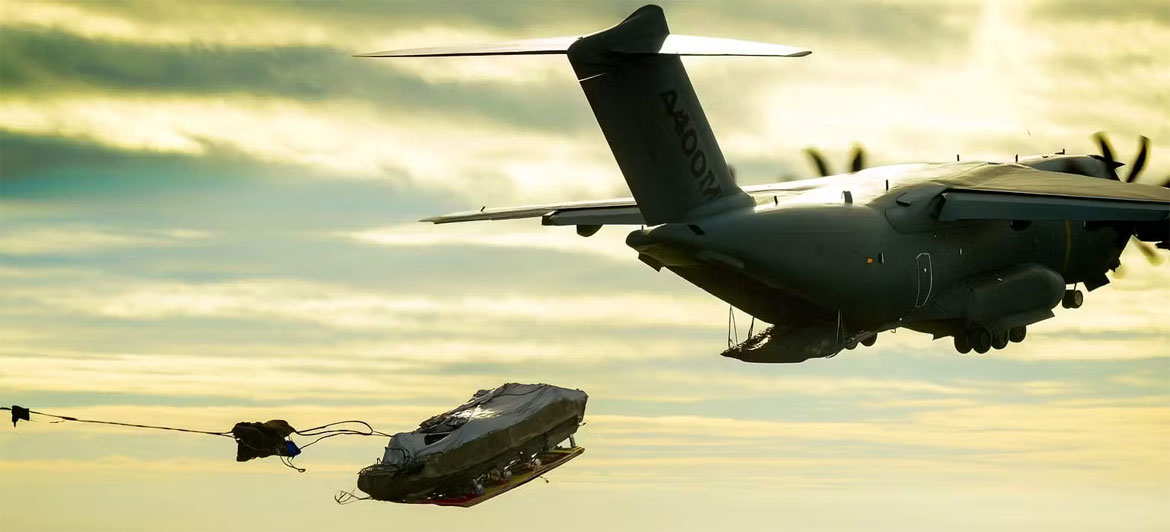
Up to 20 skilled jobs have been secured in Bridgend, South Wales, after IrvinGQ was awarded a £25 million contract to supply an advanced aerial delivery system for the RAF’s Atlas A400M transport aircraft.
The deal covers the manufacture of up to 25 systems, in-service support for up to a decade, and integration with both aircraft and maritime platforms. According to IrvinGQ, the contract will allow UK Armed Forces to airdrop rigid-hulled inflatable boats directly into maritime environments.
The system, known as PRIBAD, is designed to deploy large rigid-hulled boats ranging from 6 to 14 metres in length and weighing up to 12 tonnes. Its interchangeable cradles allow for rapid reconfiguration depending on payload, making it suitable for a range of operational commitments.
The programme has entered its Demonstration and Manufacture phase. Flight trials are planned for later this year and early 2026, conducted by the Air Test & Evaluation Centre (ATEC), led by QinetiQ and supported by the Air and Space Warfare Centre (ASWC).
Deliveries will run through 2028/29 in multiple tranches. Training for RAF and Army crews, along with maintenance teams, will accompany the rollout. IrvinGQ said the project not only strengthens UK operational readiness but also provides long-term industrial benefits for South Wales.
ukdefencejournal.org.uk
The deal covers the manufacture of up to 25 systems, in-service support for up to a decade, and integration with both aircraft and maritime platforms. According to IrvinGQ, the contract will allow UK Armed Forces to airdrop rigid-hulled inflatable boats directly into maritime environments.
The system, known as PRIBAD, is designed to deploy large rigid-hulled boats ranging from 6 to 14 metres in length and weighing up to 12 tonnes. Its interchangeable cradles allow for rapid reconfiguration depending on payload, making it suitable for a range of operational commitments.
The programme has entered its Demonstration and Manufacture phase. Flight trials are planned for later this year and early 2026, conducted by the Air Test & Evaluation Centre (ATEC), led by QinetiQ and supported by the Air and Space Warfare Centre (ASWC).
Deliveries will run through 2028/29 in multiple tranches. Training for RAF and Army crews, along with maintenance teams, will accompany the rollout. IrvinGQ said the project not only strengthens UK operational readiness but also provides long-term industrial benefits for South Wales.
ukdefencejournal.org.uk

A couple of videos of the unloading of a USAF C-5M Galaxy in Auckland

From: Lindsay Campbell, Adelaide, SA
Subject: Re: UKMAMS OBA OBB newsletters
Hi Tony,
After more than 55 years service, I’m now in the process of hanging up my flying suit and ‘downsizing’ everything to take my good lady, Sally, off to do the 'great loop’ around Australia for the next few years (on the road) or so (it is a long way around this big island).
I have really enjoyed the newsletters, but can you please take me off the mailing list. It’s time to have a jolly good 'head clean' of stuff.
Subject: Re: UKMAMS OBA OBB newsletters
Hi Tony,
After more than 55 years service, I’m now in the process of hanging up my flying suit and ‘downsizing’ everything to take my good lady, Sally, off to do the 'great loop’ around Australia for the next few years (on the road) or so (it is a long way around this big island).
I have really enjoyed the newsletters, but can you please take me off the mailing list. It’s time to have a jolly good 'head clean' of stuff.

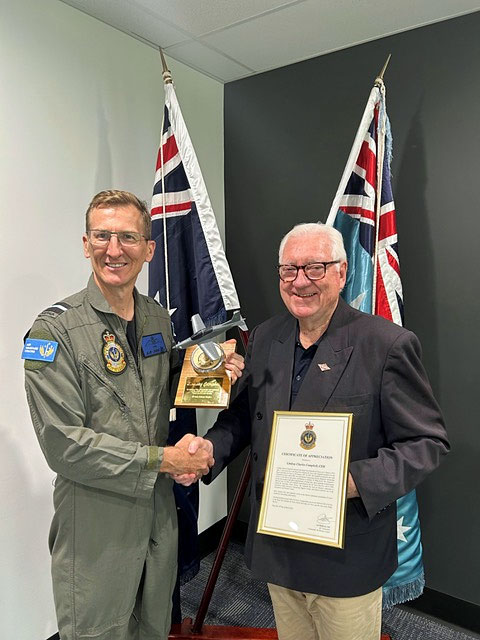
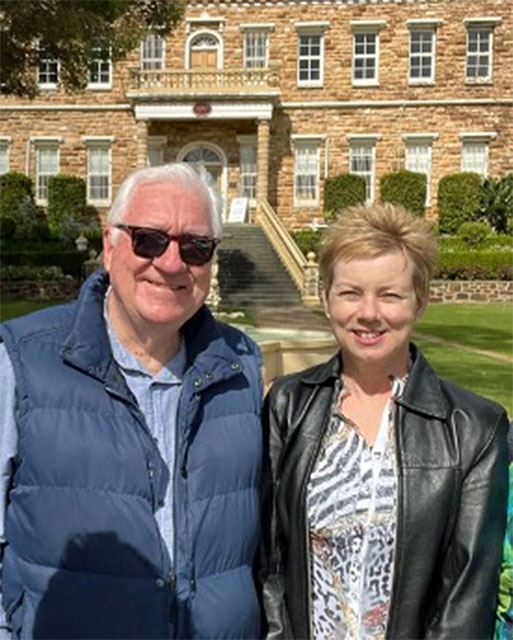
Air Commodore Steve Fifield, CDR RAAF Air Warfare Centre, presenting me with some recognition of my hitting 55 years Defence Force Service.
Sally and I are heading off to do the 'Great Loop'
Cheers mate, and great work with the newsletters.
Kind regards,
Squadron Leader (Rtd) Lindsay (‘LC’) Campbell CSM
Ex-RNZAF/Ex-RAAF
Kind regards,
Squadron Leader (Rtd) Lindsay (‘LC’) Campbell CSM
Ex-RNZAF/Ex-RAAF

H E L P !
Tony Gale
ukmamsoba@gmail.com
ukmamsoba@gmail.com
This Newsletter is Dedicated
to the Memories of:
Mick Craner (RAF)
Maureen, wife of Kit Ayers (RAF)
to the Memories of:
Mick Craner (RAF)
Maureen, wife of Kit Ayers (RAF)
.
